Paul van Yperen's Blog, page 363
November 27, 2015
Imported from the USA: Betty Amann
Dark-haired German-American actress Betty Amann (1905-1990) started her film career in Hollywood, but director Joe May and producer Erich Pommer discovered her for the German cinema. Her typical role was the immoral and alluring femme fatale who seduces and corrupts men.
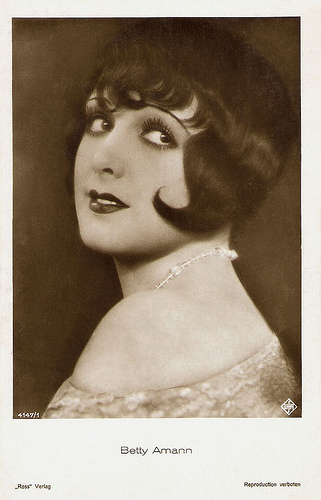
German postcard by Ross Verlag, no. 4147/1, 1929-1930. Photo: Ufa.
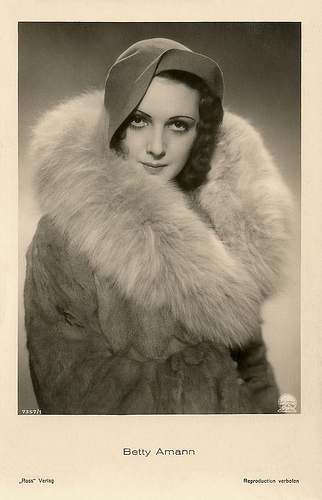
German postcard by Ross Verlag, no. 7357/1, 1932-1933. Photo: Paramount.
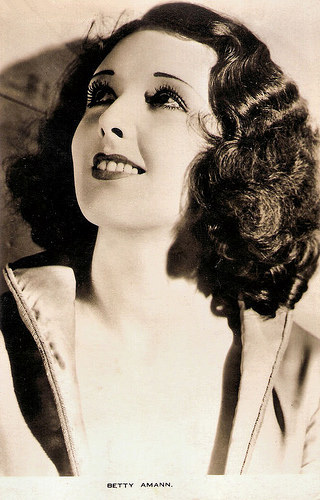
British postcard.
The Kick-off
Betty Amann was born Philippine Amann in Pirmasens, Germany, in 1905. Together with her German-American parents, she moved to the United States at an early age.
By her own account, she studied painting at the National Academy School of Fine Arts in New York before she was discovered for the stage and won small parts at the May Palace Theater.
She started her film career with the romantic movie The Kick-off (Wesley Ruggles, 1926). Under the nickname Bee Amann, she starred as a farmer's daughter opposite Tom Tyler in the western Trail of the Horse Thieves (Robert De Lacey, 1929) for the low-budget studio Film Booking Offices of America (FBO).
She returned to Germany and arrived in Berlin in the wake of Louise Brooks . Director Joe May and Ufa-producer Erich Pommer gave her a screentest, and then offered her a leading role in Asphalt (Joe May, 1929). In this masterpiece of the German silent cinema she played a femme fatale thief who corrupts true-blue policeman Gustav Fröhlich . It was Pommer who gave her the pseudonym Betty.
In her next film, Der Sträfling aus Stambul/The Convict From Stambul (Gustav Ucicky, 1929), she was the co-star of Heinrich George and Paul Hörbiger . Soon, more films followed.
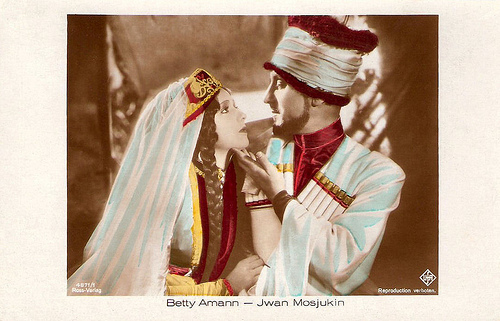
German postcard by Ross Verlag, no. 4871/1, 1929-1930 with Ivan Mozzhukhin . Photo: Ufa.
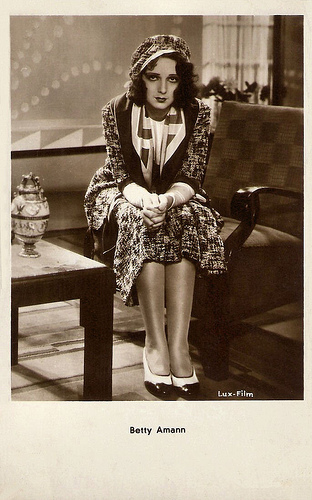
Austrian postcard by Iris Verlag, no. 6016. Photo: Lux-Film.
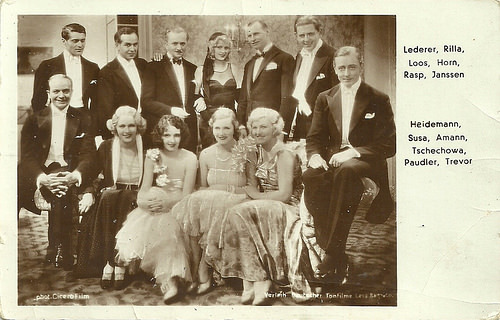
German postcard. Photo: Cicero Film / Distribution Deutsche Tonfilme. The 'fine fleur' of late silent German cinema stars, united for a photo for an early sound film company. Standing left to right: Francis/Franz Lederer, Walter Rilla, Theodor Loos, Camilla Horn, Fritz Rasp and Walter Janssen, Sitting left to right: Paul Heidemann, Charlotte Susa, Betty Amann, Olga Tschechowa, Maria Paudler and Jack Trevor. Publicity for the early sound comedy Die grosse Sehnsucht/The Great Longing (Stefan Szekely/Steve Sekely, 1930), in which all acted, mostly as themselves - only Loos and Horn played characters. The plot was an excuse for 35 stars to debut in a talking picture.
Mosjoukine
Betty Amann was the leading lady of the Ufa production Der Weisse Teufel/The White Devil (Alexandre Volkoff, 1929), based on a novel by Leo Tolstoy.
With great style and visual flare Alexandre Volkoff directed this film that represented the European silent tradition at it's finest and most dynamic. Russian émigré Ivan Mozzhukhin , the great star of the French silent cinema aka ‘Mosjoukine’, features as a fiery Caucasian captain Hadscht Murat.
Der Weisse Teufel was his first film to include a synchronised soundtrack: existing of an effective score by Michael Lewin and others, some sequences of singing and whistling, and a range of sound effects, but no dialogue.
The later director Michael Powell was apparently the stills photographer on the film and therefore may be the maker of the photo used for the postcard above.
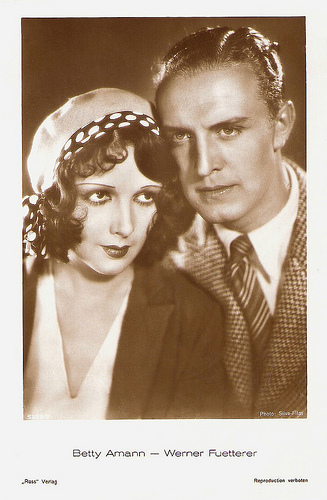
German postcard by Ross Verlag, no. 5325/2, 1930-1931. Photo: Silva-Film. Publicity still for O alte Burschenherrlichkeit/Oh Those Glorious Old Student Days (Rolf Randolf, 1930) with Werner Fuetterer .
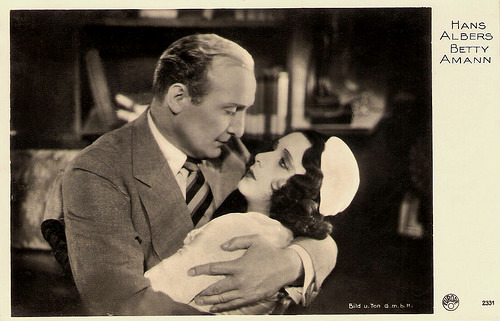
French postcard by Europe, no. 2331. Photo: Bild und Ton GmbH. Publicity still for Hans in allen Gassen/Hans-of-all-trades (Carl Froelich, 1930) with Hans Albers.
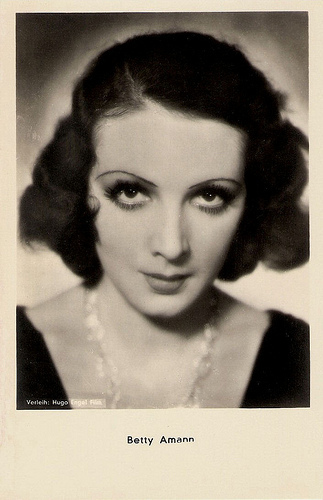
Austrian postcard by Iris Verlag, no. 6782. Photo: Verleih Hugo Engel Film. Still for Der Grosse Bluff/The Big Bluff (Georg Jacoby, 1933).
Rich and Strange
When the sound film arrived Betty Amann kept working in Germany. In the crime film Hans in allen Gassen/Hans in All Alleys (Carl Froelich, 1930), she co-starred with Hans Albers as an alluring stranger who turns out to be a murderess.
From 1931 on she also worked in England. For Alfred Hitchcock she played a trickster in the romantic comedy Rich and Strange (Alfred Hitchcock, 1931). In 1933 she emigrated to Great-Britain.
One of her last roles in a German film was in Schleppzug M 17/Tugboat M 17 ( Heinrich George , Werner Hochbaum, 1933) as a prostitute and thief who seduces a family man.
By 1938, she was married to the lawyer David B. Stillman and took up permanent residence in the United States, where she shot the western In Old Mexico (Edward D. Venturini, 1938) with William Boyd. One year later, she could be seen in Nancy Drew… Reporter (William Clemens, 1939), a movie which was part of the Nancy Drew series starring Bonita Granville.
Her last role was one of Gale Sondergaard's harbour prostitutes in the bizarre treasure hunter movie Isle of Forgotten Sins (Edgar G. Ulmer, 1943).
In 1987 Betty Amann was awarded the Filmband in Gold for her attributions to the German cinema. She died in 1990 in Westport, USA.
A scene from Asphalt (1929). Source: Golden Silents (YouTube).
Another scene from Asphalt (1929). Source: Saskia (YouTube).
A scene from Der Weisse Teufel/The White Devil (1929), including a vintage soundtrack made the same year to fit the film with sound. Source: Golden Silents (YouTube).
Sources: Hans J. Wollstein (AllMovie), Thomas Hamilton (IMDb), Filmportal.de, Wikipedia, and .

German postcard by Ross Verlag, no. 4147/1, 1929-1930. Photo: Ufa.

German postcard by Ross Verlag, no. 7357/1, 1932-1933. Photo: Paramount.

British postcard.
The Kick-off
Betty Amann was born Philippine Amann in Pirmasens, Germany, in 1905. Together with her German-American parents, she moved to the United States at an early age.
By her own account, she studied painting at the National Academy School of Fine Arts in New York before she was discovered for the stage and won small parts at the May Palace Theater.
She started her film career with the romantic movie The Kick-off (Wesley Ruggles, 1926). Under the nickname Bee Amann, she starred as a farmer's daughter opposite Tom Tyler in the western Trail of the Horse Thieves (Robert De Lacey, 1929) for the low-budget studio Film Booking Offices of America (FBO).
She returned to Germany and arrived in Berlin in the wake of Louise Brooks . Director Joe May and Ufa-producer Erich Pommer gave her a screentest, and then offered her a leading role in Asphalt (Joe May, 1929). In this masterpiece of the German silent cinema she played a femme fatale thief who corrupts true-blue policeman Gustav Fröhlich . It was Pommer who gave her the pseudonym Betty.
In her next film, Der Sträfling aus Stambul/The Convict From Stambul (Gustav Ucicky, 1929), she was the co-star of Heinrich George and Paul Hörbiger . Soon, more films followed.

German postcard by Ross Verlag, no. 4871/1, 1929-1930 with Ivan Mozzhukhin . Photo: Ufa.

Austrian postcard by Iris Verlag, no. 6016. Photo: Lux-Film.

German postcard. Photo: Cicero Film / Distribution Deutsche Tonfilme. The 'fine fleur' of late silent German cinema stars, united for a photo for an early sound film company. Standing left to right: Francis/Franz Lederer, Walter Rilla, Theodor Loos, Camilla Horn, Fritz Rasp and Walter Janssen, Sitting left to right: Paul Heidemann, Charlotte Susa, Betty Amann, Olga Tschechowa, Maria Paudler and Jack Trevor. Publicity for the early sound comedy Die grosse Sehnsucht/The Great Longing (Stefan Szekely/Steve Sekely, 1930), in which all acted, mostly as themselves - only Loos and Horn played characters. The plot was an excuse for 35 stars to debut in a talking picture.
Mosjoukine
Betty Amann was the leading lady of the Ufa production Der Weisse Teufel/The White Devil (Alexandre Volkoff, 1929), based on a novel by Leo Tolstoy.
With great style and visual flare Alexandre Volkoff directed this film that represented the European silent tradition at it's finest and most dynamic. Russian émigré Ivan Mozzhukhin , the great star of the French silent cinema aka ‘Mosjoukine’, features as a fiery Caucasian captain Hadscht Murat.
Der Weisse Teufel was his first film to include a synchronised soundtrack: existing of an effective score by Michael Lewin and others, some sequences of singing and whistling, and a range of sound effects, but no dialogue.
The later director Michael Powell was apparently the stills photographer on the film and therefore may be the maker of the photo used for the postcard above.

German postcard by Ross Verlag, no. 5325/2, 1930-1931. Photo: Silva-Film. Publicity still for O alte Burschenherrlichkeit/Oh Those Glorious Old Student Days (Rolf Randolf, 1930) with Werner Fuetterer .

French postcard by Europe, no. 2331. Photo: Bild und Ton GmbH. Publicity still for Hans in allen Gassen/Hans-of-all-trades (Carl Froelich, 1930) with Hans Albers.

Austrian postcard by Iris Verlag, no. 6782. Photo: Verleih Hugo Engel Film. Still for Der Grosse Bluff/The Big Bluff (Georg Jacoby, 1933).
Rich and Strange
When the sound film arrived Betty Amann kept working in Germany. In the crime film Hans in allen Gassen/Hans in All Alleys (Carl Froelich, 1930), she co-starred with Hans Albers as an alluring stranger who turns out to be a murderess.
From 1931 on she also worked in England. For Alfred Hitchcock she played a trickster in the romantic comedy Rich and Strange (Alfred Hitchcock, 1931). In 1933 she emigrated to Great-Britain.
One of her last roles in a German film was in Schleppzug M 17/Tugboat M 17 ( Heinrich George , Werner Hochbaum, 1933) as a prostitute and thief who seduces a family man.
By 1938, she was married to the lawyer David B. Stillman and took up permanent residence in the United States, where she shot the western In Old Mexico (Edward D. Venturini, 1938) with William Boyd. One year later, she could be seen in Nancy Drew… Reporter (William Clemens, 1939), a movie which was part of the Nancy Drew series starring Bonita Granville.
Her last role was one of Gale Sondergaard's harbour prostitutes in the bizarre treasure hunter movie Isle of Forgotten Sins (Edgar G. Ulmer, 1943).
In 1987 Betty Amann was awarded the Filmband in Gold for her attributions to the German cinema. She died in 1990 in Westport, USA.
A scene from Asphalt (1929). Source: Golden Silents (YouTube).
Another scene from Asphalt (1929). Source: Saskia (YouTube).
A scene from Der Weisse Teufel/The White Devil (1929), including a vintage soundtrack made the same year to fit the film with sound. Source: Golden Silents (YouTube).
Sources: Hans J. Wollstein (AllMovie), Thomas Hamilton (IMDb), Filmportal.de, Wikipedia, and .
Published on November 27, 2015 22:00
November 26, 2015
EFSP's Dazzling Dozen: The Lubitsch Touch
German-American director Ernst Lubitsch (1892-1947) had the reputation of being Hollywood's most elegant and sophisticated director. His films were promoted as having ‘the Lubitsch touch.’ In the 1910s, he had started out as an actor and director in the silent cinema of the Weimar republic. In Berlin, he made his first masterpieces with stars like Ossi Oswalda, Henny Porten and Pola Negri. Today on EFSP, twelve dazzling postcards with the Lubitsch Touch.
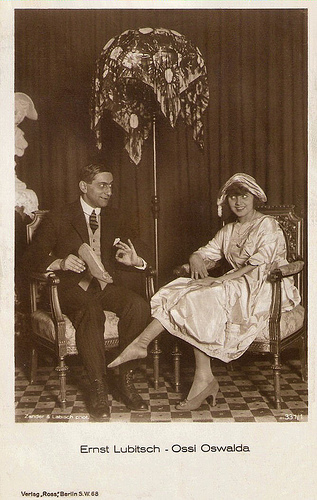
Ernst Lubitsch and Ossi Oswalda . German postcard by Ross Verlag, Berlin, no. 337/1, 1919-1924. Photo: Zander & Labisch.
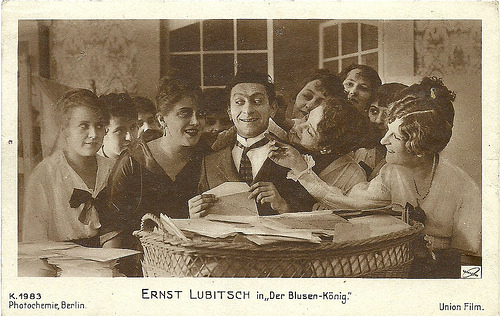
German postcard by Photochemie, no. K. 1983. Photo: Union Film. Publicity still for Der Blusen-König (Ernst Lubitsch, 1917) starring Ernst Lubitsch himself. Collection: Didier Hanson.
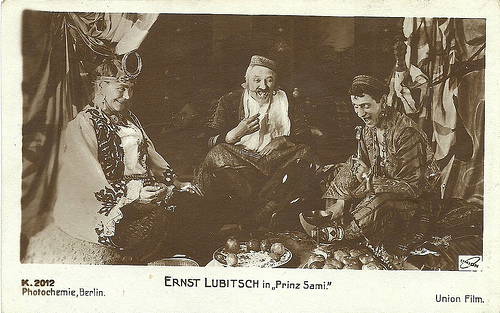
German postcard by Photochemie, Berlin, no. K. 2012. Photo: Union Film. Publicity still for Prinz Sami/Prince Sami (Ernst Lubitsch, 1918), again with Ernst Lubitsch in the leading role. Collection: Didier Hanson.
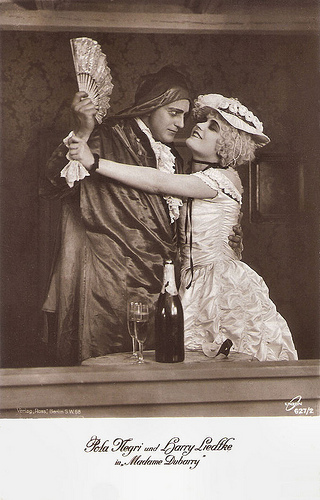
German postcard by Ross Verlag, Berlin, no. 627/2. Photo: Union. Publicity still for Madame DuBarry (Ernst Lubitsch, 1919) with Pola Negri and Harry Liedtke .
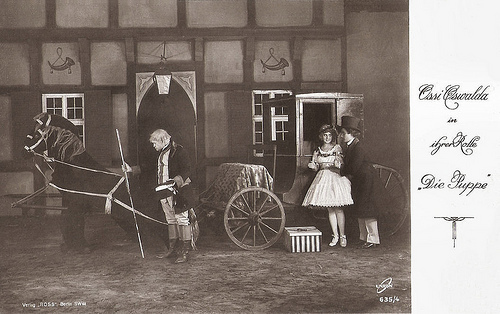
German postcard by Ross Verlag, Berlin, no. 635/4. Photo: Union. Publicity still for Die Puppe/The Doll (Ernst Lubitsch, 1919) with Ossi Oswalda and Hermann Thimig .
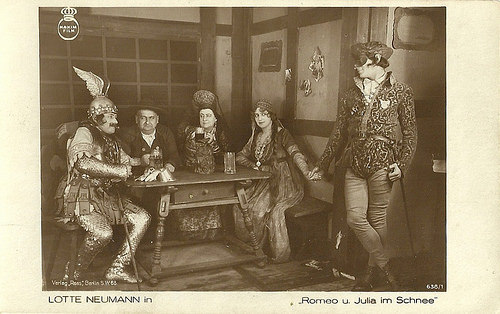
German postcard by Ross Verlag, no. 636/1. Photo: Maxim Film production. Publicity still for the comedy Romeo und Julia im Schnee/Romeo and Juliet in the Snow (Ernst Lubitsch, 1920). The man on the left dressed as antique hero could be Julius Falkenstein as Paris. The others are from left to right Jakob Tiedtke (Herr Capulethofer), Marga Köhler (his wife), Lotte Neumann (Julia) and Gustav von Wangenheim (Romeo Montekugerl).
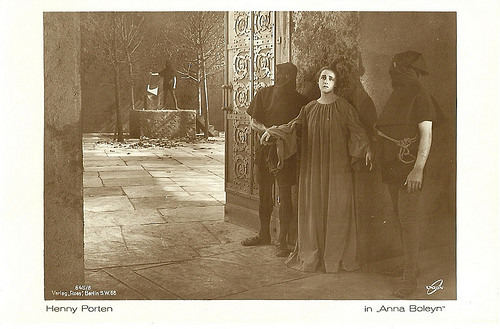
German postcard by Ross Verlag, no. 645/8. Photo: Union Film. Henny Porten in the drama Anna Boleyn (Ernst Lubitsch, 1920).
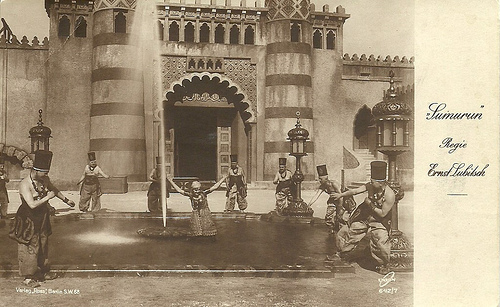
German postcard by Ross Verlag, Berlin, no. 642/7. Photo: Union Film. Publicity still for Sumurun (Ernst Lubitsch, 1920) with Pola Negri . Collection: Didier Hanson.
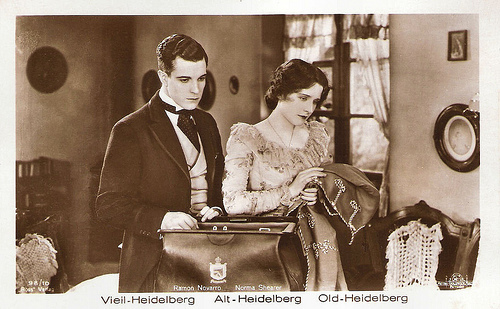
German postcard by Ross Verlag, no. 98/10. Photo: Metro-Goldwyn-Mayer. Publicity still for The Student Prince in Old Heidelberg (Ernst Lubitsch, 1927) with Ramon Novarro and Norma Shearer.
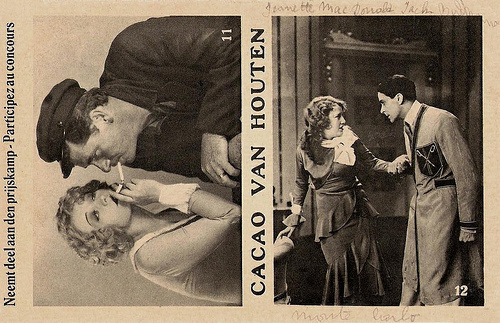
Dutch-Belgian promotion card for Cacao Van Houten, no. 11 and 12. Printed by N.V. Ned Reclamefabriek. This card was part of a series of promo cards for a quiz by Van Houten Chocolate. The public had to go to stores to guess which film star was on the photo in the shop window. There were 24 photos. At the right Jack Buchanan and Jeanette MacDonald in Monte Carlo (Ernst Lubitsch, 1930).
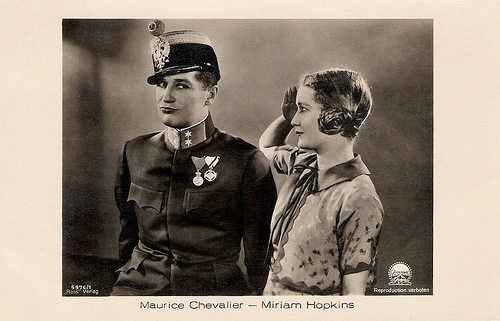
German postcard by Ross Verlag, no. 5976/1, 1931-1932. Photo: Paramount. Publicity still for The Smiling Lieutenant (Ernst Lubitsch, 1931) with Maurice Chevalier and Miriam Hopkins.
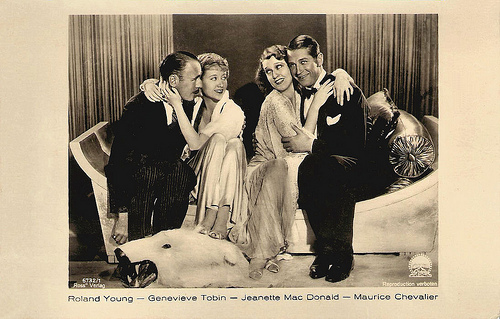
German postcard by Ross Verlag, no. 6732/1, 1931-1932. Photo: Paramount. Publicity still for One Hour with You (Ernst Lubitsch, 1932) with Roland Young, Genevieve Tobin, Jeanette MacDonald and Maurice Chevalier .
This is a post for Postcard Friendship Friday, hosted by Beth at the The Best Hearts are Crunchy. You can visit her by clicking on the button below.


Ernst Lubitsch and Ossi Oswalda . German postcard by Ross Verlag, Berlin, no. 337/1, 1919-1924. Photo: Zander & Labisch.

German postcard by Photochemie, no. K. 1983. Photo: Union Film. Publicity still for Der Blusen-König (Ernst Lubitsch, 1917) starring Ernst Lubitsch himself. Collection: Didier Hanson.

German postcard by Photochemie, Berlin, no. K. 2012. Photo: Union Film. Publicity still for Prinz Sami/Prince Sami (Ernst Lubitsch, 1918), again with Ernst Lubitsch in the leading role. Collection: Didier Hanson.

German postcard by Ross Verlag, Berlin, no. 627/2. Photo: Union. Publicity still for Madame DuBarry (Ernst Lubitsch, 1919) with Pola Negri and Harry Liedtke .

German postcard by Ross Verlag, Berlin, no. 635/4. Photo: Union. Publicity still for Die Puppe/The Doll (Ernst Lubitsch, 1919) with Ossi Oswalda and Hermann Thimig .

German postcard by Ross Verlag, no. 636/1. Photo: Maxim Film production. Publicity still for the comedy Romeo und Julia im Schnee/Romeo and Juliet in the Snow (Ernst Lubitsch, 1920). The man on the left dressed as antique hero could be Julius Falkenstein as Paris. The others are from left to right Jakob Tiedtke (Herr Capulethofer), Marga Köhler (his wife), Lotte Neumann (Julia) and Gustav von Wangenheim (Romeo Montekugerl).

German postcard by Ross Verlag, no. 645/8. Photo: Union Film. Henny Porten in the drama Anna Boleyn (Ernst Lubitsch, 1920).

German postcard by Ross Verlag, Berlin, no. 642/7. Photo: Union Film. Publicity still for Sumurun (Ernst Lubitsch, 1920) with Pola Negri . Collection: Didier Hanson.

German postcard by Ross Verlag, no. 98/10. Photo: Metro-Goldwyn-Mayer. Publicity still for The Student Prince in Old Heidelberg (Ernst Lubitsch, 1927) with Ramon Novarro and Norma Shearer.

Dutch-Belgian promotion card for Cacao Van Houten, no. 11 and 12. Printed by N.V. Ned Reclamefabriek. This card was part of a series of promo cards for a quiz by Van Houten Chocolate. The public had to go to stores to guess which film star was on the photo in the shop window. There were 24 photos. At the right Jack Buchanan and Jeanette MacDonald in Monte Carlo (Ernst Lubitsch, 1930).

German postcard by Ross Verlag, no. 5976/1, 1931-1932. Photo: Paramount. Publicity still for The Smiling Lieutenant (Ernst Lubitsch, 1931) with Maurice Chevalier and Miriam Hopkins.

German postcard by Ross Verlag, no. 6732/1, 1931-1932. Photo: Paramount. Publicity still for One Hour with You (Ernst Lubitsch, 1932) with Roland Young, Genevieve Tobin, Jeanette MacDonald and Maurice Chevalier .
This is a post for Postcard Friendship Friday, hosted by Beth at the The Best Hearts are Crunchy. You can visit her by clicking on the button below.

Published on November 26, 2015 22:00
November 25, 2015
Jenny Hasselqvist
Jenny Hasselqvist (1894-1978) was a Swedish ballet dancer and actress who starred in silent Swedish films by Mauritz Stiller and Victor Sjöström. She also worked in Germany with Ernst Lubitsch and became well-known all over Europe. With the rise of the sound film she concluded her film career.
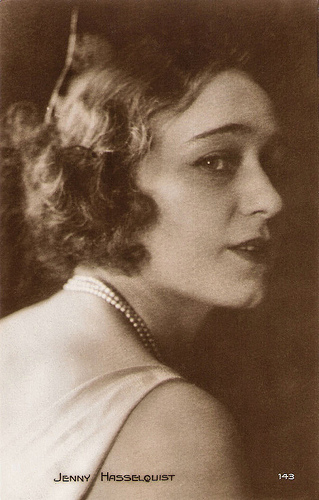
French postcard by Editions Cinémagazine, no. 143. Swedish actress Jenny Hasselqvist aka Jenny Hasselquist.
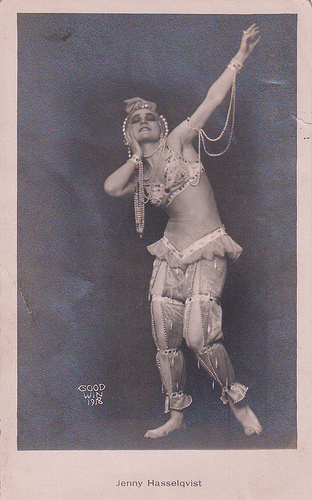
Vintage postcard. Photo: Henry B. Goodwin, 1918. Collection: Marlène Pilaete.
Prima Donna
Jenny Matilda Elisabet Hasselqvist (or Hasselquist) was born in 1894 in Stockholm, Sweden. Her father was a member of parliament. From 1906 on, Jenny attended the Swedish Opera's ballet school and from 1910, she performed with the Royal Ballet.
In 1913, famous Russian choreographer Michel Fokine noticed her talents and ensured she obtained solo parts in La Sylphide and Cleopatra. She had a brilliant success and became a prima ballerina at the Royal Ballet in 1915.
In 1916, Hasselqvist made her film debut in Balettprimadonnan/Anjala the Dancer, directed by the legendary Mauritz Stiller. She got the title role because it required a professional dancer. At IMDb , ‘Herr Graf’ Ferdinand Von Galitzien highly recommends the film of which now only some fragments remain. ‘Genuine Stiller’, he calls the tale of a gypsy dancer (Hasselquist) who is discovered accidentally by a violin player ( Lars Hanson ). Von Galitzien about the film’s ending: “a thrilling sequence with our heroine running wild through a snowy landscape trying to avoid a calamity between the men that are fighting for her love (…), a lyrical and beautiful ending wherein Nature (Swedish style) is also an important dramatic character.”
Hasselqvist continued to dance. In 1919, she retired from the Royal Ballet, and became from 1919 till 1921 a star of Les ballets Anglais in Paris. Wikipedia : “A talented dancer, she had a flair for the modern idiom.” She also pursued a career in the silent cinema. With Mauritz Stiller, she made Johan/ Rapids of Life (Mauritz Stiller, 1921) with Mathias Taube and De landsflyktige/The Emigrants (Mauritz Stiller, 1921).
Then she worked with the other great director of the Swedish silent cinema, Victor Sjöström at Vem dömer/Love’s Crucible (Victor Sjöström, 1922) with Gösta Ekman , and Eld ombord/Fire on Board (Victor Sjöström, 1923) opposite British actor Matheson Lang and Victor Sjöström himself.
One of her best known films is Gösta Berlings saga/The Atonement of Gosta Berling (Mauritz Stiller, 1924) starring Lars Hanson and the young Greta Garbo . Hal Erickson at AllMovie : “The Atonement of Gosta Berling is an excellent representation of the Swedish silent cinema. Long, complex, and elaborately produced, the film nonetheless never loses sight of the human elements which motivate the story.”
Hasselqvist also worked with Gustaf Molander at the Selma Lagerlöf adaptations Ingmarsarvet/The Ingmar Inheritance (Gustaf Molander, 1925) and Till österland/To the Orient (Gustaf Molander, 1926), with Lars Hanson and Ivan Hedqvist.
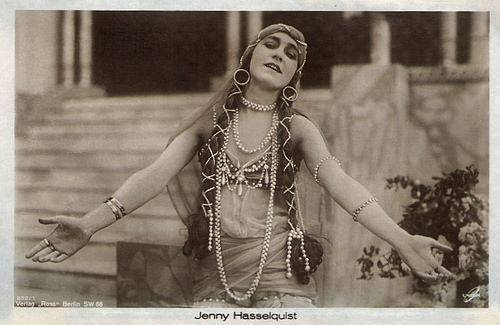
German postcard by Ross Verlag, Berlin, no. 832/1, 1919-1924. Union Film. Publicity still for Sumurun (Ernst Lubitsch, 1920).
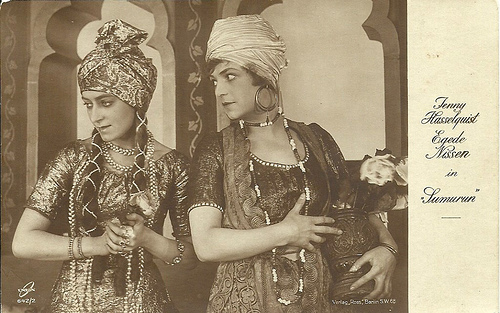
German postcard by Ross Verlag, Berlin, no. 642/2,1919-1924. Union Film. Publicity still for Sumurun (Ernst Lubitsch, 1920) with Jenny Hasselquist and Aud Egede Nissen . Collection: Didier Hanson.
Sumurun
Jenny Hasselqvist also worked in Germany. In 1920, Ernst Lubitsch offered her the title role in his film version of Max Reinhardt's stage pantomime Sumurun/One Arabian Night (Ernst Lubitsch, 1920), opposite Ernst Lubitsch himself and Pola Negri . Hasselqvist played the favourite slave girl of a tyrannical sheik ( Paul Wegener ), who falls in love with a cloth merchant ( Harry Liedtke ). The film was huge international success and she became well-known in Europe.
In Germany she also played in Das brennende Geheimnis/The Burning Secret (Rochus Gliese, 1923) and Die Perücke/The Wig (Berthold Viertel, 1925) as the wife of Otto Gebühr . About the latter Gwynplaine writes at IMDb : “It's been ten years since I seen Berthold Viertel's compelling film Die Perucke (or the Wig) at the Pordenone Silent Film Festival back in 1997. But of all the films I seen throughout that eventful week (including some impressive silents from China...) I would have to say that Die Perucke was the most impressive. The story concerns a man in the 1920s who, while visiting an antique shop, discovers an old powdered wig. While trying the wig on he is instantly whisked back to the 1700's & becomes the nobleman who originally wore the wig.”
Hasselqvist’s later German films include Brennende Grenze/Aftermath (Erich Waschneck, 1927) and Schuldig/Guilty (Johannes Meyer, 1928) with Suzy Vernon . With the rise of the sound film she concluded her film career. Her final film was the Paramount production Den farliga leken (Gustaf Bergman, 1931), an alternative language version of The Laughing Lady (Victor Schertzinger, 1929) with Ruth Chatterton.
Hasselqvist had starred in 20 films, but the voice was not her medium. During her film career, she had appeared as a guest dancer in many of Europe's leading theatres including the Coliseum in London, the Théâtre des Champs-Élysées in Paris and the Deutsches Theater in Berlin. From the mid-1930s on, she had her own ballet school in Stockholm, and in the early 1950s, she also taught at the Stockholm Opera's ballet school. In between she incidentally returned to act on stage.
At the age of 83, Jenny Hasselqvist died in 1978 in Täby, near Stockholm. She was married with artist, painter and ceramist Wilhelm Kage (1918-1922) and with garden architect Gösta Reuterswärd (1923-1927).
Short dance fragment of Jenny Hasselquist performing Die weiße Rose (The White Rose), from the German 'health and efficiency' film Wege Zu Kraft und Schonheit/Paths to the Power & Beauty (1925). Source: John Hall (YouTube).
Homage to Lars Hanson and Jenny Hasselqvist in 1924, with Cristal um tango sung by Francisco Alves. Source: Radio Santos (YouTube).
Sources: Ferdinand Von Galitzien (IMDb), Gwynplaine (IMDb), Bengt Forslund (The Swedish Film Database - Swedish), Wikipedia (English and Swedish) and .

French postcard by Editions Cinémagazine, no. 143. Swedish actress Jenny Hasselqvist aka Jenny Hasselquist.

Vintage postcard. Photo: Henry B. Goodwin, 1918. Collection: Marlène Pilaete.
Prima Donna
Jenny Matilda Elisabet Hasselqvist (or Hasselquist) was born in 1894 in Stockholm, Sweden. Her father was a member of parliament. From 1906 on, Jenny attended the Swedish Opera's ballet school and from 1910, she performed with the Royal Ballet.
In 1913, famous Russian choreographer Michel Fokine noticed her talents and ensured she obtained solo parts in La Sylphide and Cleopatra. She had a brilliant success and became a prima ballerina at the Royal Ballet in 1915.
In 1916, Hasselqvist made her film debut in Balettprimadonnan/Anjala the Dancer, directed by the legendary Mauritz Stiller. She got the title role because it required a professional dancer. At IMDb , ‘Herr Graf’ Ferdinand Von Galitzien highly recommends the film of which now only some fragments remain. ‘Genuine Stiller’, he calls the tale of a gypsy dancer (Hasselquist) who is discovered accidentally by a violin player ( Lars Hanson ). Von Galitzien about the film’s ending: “a thrilling sequence with our heroine running wild through a snowy landscape trying to avoid a calamity between the men that are fighting for her love (…), a lyrical and beautiful ending wherein Nature (Swedish style) is also an important dramatic character.”
Hasselqvist continued to dance. In 1919, she retired from the Royal Ballet, and became from 1919 till 1921 a star of Les ballets Anglais in Paris. Wikipedia : “A talented dancer, she had a flair for the modern idiom.” She also pursued a career in the silent cinema. With Mauritz Stiller, she made Johan/ Rapids of Life (Mauritz Stiller, 1921) with Mathias Taube and De landsflyktige/The Emigrants (Mauritz Stiller, 1921).
Then she worked with the other great director of the Swedish silent cinema, Victor Sjöström at Vem dömer/Love’s Crucible (Victor Sjöström, 1922) with Gösta Ekman , and Eld ombord/Fire on Board (Victor Sjöström, 1923) opposite British actor Matheson Lang and Victor Sjöström himself.
One of her best known films is Gösta Berlings saga/The Atonement of Gosta Berling (Mauritz Stiller, 1924) starring Lars Hanson and the young Greta Garbo . Hal Erickson at AllMovie : “The Atonement of Gosta Berling is an excellent representation of the Swedish silent cinema. Long, complex, and elaborately produced, the film nonetheless never loses sight of the human elements which motivate the story.”
Hasselqvist also worked with Gustaf Molander at the Selma Lagerlöf adaptations Ingmarsarvet/The Ingmar Inheritance (Gustaf Molander, 1925) and Till österland/To the Orient (Gustaf Molander, 1926), with Lars Hanson and Ivan Hedqvist.

German postcard by Ross Verlag, Berlin, no. 832/1, 1919-1924. Union Film. Publicity still for Sumurun (Ernst Lubitsch, 1920).

German postcard by Ross Verlag, Berlin, no. 642/2,1919-1924. Union Film. Publicity still for Sumurun (Ernst Lubitsch, 1920) with Jenny Hasselquist and Aud Egede Nissen . Collection: Didier Hanson.
Sumurun
Jenny Hasselqvist also worked in Germany. In 1920, Ernst Lubitsch offered her the title role in his film version of Max Reinhardt's stage pantomime Sumurun/One Arabian Night (Ernst Lubitsch, 1920), opposite Ernst Lubitsch himself and Pola Negri . Hasselqvist played the favourite slave girl of a tyrannical sheik ( Paul Wegener ), who falls in love with a cloth merchant ( Harry Liedtke ). The film was huge international success and she became well-known in Europe.
In Germany she also played in Das brennende Geheimnis/The Burning Secret (Rochus Gliese, 1923) and Die Perücke/The Wig (Berthold Viertel, 1925) as the wife of Otto Gebühr . About the latter Gwynplaine writes at IMDb : “It's been ten years since I seen Berthold Viertel's compelling film Die Perucke (or the Wig) at the Pordenone Silent Film Festival back in 1997. But of all the films I seen throughout that eventful week (including some impressive silents from China...) I would have to say that Die Perucke was the most impressive. The story concerns a man in the 1920s who, while visiting an antique shop, discovers an old powdered wig. While trying the wig on he is instantly whisked back to the 1700's & becomes the nobleman who originally wore the wig.”
Hasselqvist’s later German films include Brennende Grenze/Aftermath (Erich Waschneck, 1927) and Schuldig/Guilty (Johannes Meyer, 1928) with Suzy Vernon . With the rise of the sound film she concluded her film career. Her final film was the Paramount production Den farliga leken (Gustaf Bergman, 1931), an alternative language version of The Laughing Lady (Victor Schertzinger, 1929) with Ruth Chatterton.
Hasselqvist had starred in 20 films, but the voice was not her medium. During her film career, she had appeared as a guest dancer in many of Europe's leading theatres including the Coliseum in London, the Théâtre des Champs-Élysées in Paris and the Deutsches Theater in Berlin. From the mid-1930s on, she had her own ballet school in Stockholm, and in the early 1950s, she also taught at the Stockholm Opera's ballet school. In between she incidentally returned to act on stage.
At the age of 83, Jenny Hasselqvist died in 1978 in Täby, near Stockholm. She was married with artist, painter and ceramist Wilhelm Kage (1918-1922) and with garden architect Gösta Reuterswärd (1923-1927).
Short dance fragment of Jenny Hasselquist performing Die weiße Rose (The White Rose), from the German 'health and efficiency' film Wege Zu Kraft und Schonheit/Paths to the Power & Beauty (1925). Source: John Hall (YouTube).
Homage to Lars Hanson and Jenny Hasselqvist in 1924, with Cristal um tango sung by Francisco Alves. Source: Radio Santos (YouTube).
Sources: Ferdinand Von Galitzien (IMDb), Gwynplaine (IMDb), Bengt Forslund (The Swedish Film Database - Swedish), Wikipedia (English and Swedish) and .
Published on November 25, 2015 22:00
November 24, 2015
Un long dimanche de fiancailles (2004)
Un long dimanche de fiançailles/A Very Long Engagement (2004) is a French romantic war film, co-written and directed by Jean-Pierre Jeunet and starring Audrey Tautou. It is a fictional tale about a young woman's desperate search for her fiance who might have been killed during World War I. It was based on a novel of the same name, written by Sebastien Japrisot, first published in 1991.
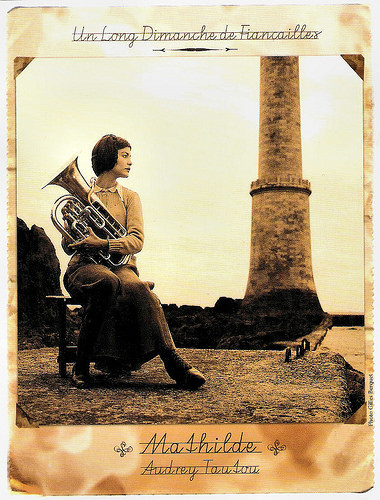
French postcard by Warner Bros, France / Tapioca Films / TF1 Films Production. Poster by Laurent Lufroy. Photo: Bruno Calvo. Publicity still for Un long dimanche de fiançailles/A Very Long Engagement (Jean-Pierre Jeunet, 2004) with Audrey Tautou as Mathilde.
Manech's Marrying Mathilde
Un long dimanche de fiançailles/A Very Long Engagement (2004) tells the romantic story of Mathilde (Audrey Tautou), a young woman who relentless searches for her fiance Manech (Gaspard Ulliel) during World War I.
Near the Somme, five French soldiers are convicted of self-mutilation in order to escape military service. They are condemned to face near certain death in the no man's land between the French and German trench lines. It appears that all of them were killed in a subsequent battle.
Mathilde, the fiancee of one of the soldiers, refuses to give up hope and begins to uncover clues as to what actually took place on the battlefield. Her task is not made any easier for her due to a bout with polio as a child. She is all the while driven by the constant reminder of what her fiance had carved into one of the bells of the church near their home, MMM for Manech's Marrying Mathilde (actually in French: Manech aime Mathilde = Manech Loves Mathilde).
With the help of a private investigator, she attempts to find out what happened to her fiance. Along the way, she discovers the brutally corrupt system used by the French government to deal with those who tried to escape the front. She also discovers the stories of the other men who were sentenced to the no man's land as a punishment.
The story is told both from the point of view of the fiancee in Paris and the French countryside—mostly Brittany—of the 1920s, and through flashbacks to the battlefield.
Eventually Mathilde finds out her fiance is alive, but he suffers from amnesia. He fails to identify even his adoptive mother. Seeing Mathilde, Manech seems to be oblivious of her. However, he still expresses concern for her when he notices her polio stricken legs, asking her "does it hurt when you walk ?" as he did when they first met. At this, Mathilde sits on the garden chair silently watching Manech with tears in her eyes and a smile on her lips.
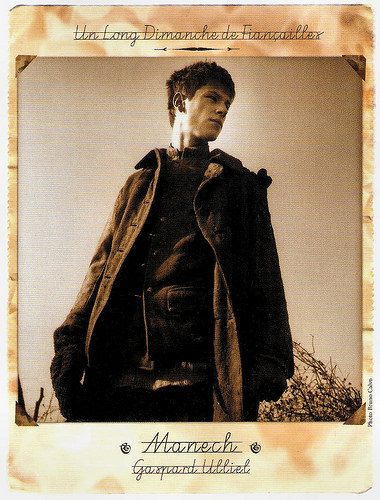
French postcard by Warner Bros, France / Tapioca Films / TF1 Films Production. Poster by Laurent Lufroy. Photo: Bruno Calvo. Publicity still for Un long dimanche de fiançailles/A Very Long Engagement (Jean-Pierre Jeunet, 2004) with Gaspard Ulliel as Manech.
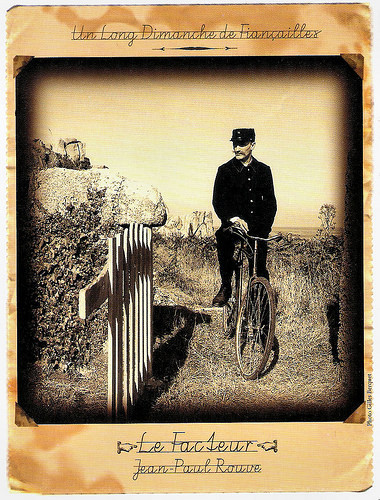
French postcard by Warner Bros, France / Tapioca Films / TF1 Films Production. Poster by Laurent Lufroy. Photo: Bruno Calvo. Publicity still for Un long dimanche de fiançailles/A Very Long Engagement (Jean-Pierre Jeunet, 2004) with Jean-Paul Rouve as the mailman.
A visual tour de force
Director Jean-Pierre Jeunet had a surprise smash with Amélie (2001), featuring the expressive Audrey Tatou as a whimsical and charming girl-woman in search of love. In his follow-up film, Un long dimanche de fiancailles, Jeunet crafted a moving, often penetrating drama, set during the darkest days of World War I and its immediate aftermath.
Audrey Tatou returned and plays pretty but frail Mathilde, a loner separated from her peers by her disability. She becomes closest friends with Maneche, the son of a lighthouse keeper. Late adolescence brings love and lust, commitment and an engagement. And when Maneche does not return from the war, Mathilde searches fervently for him, steely faithful in a moving and believable way.
Ralph Michael Stein at IMDb : "her search takes her to cities and battlefields. With resort to a child's employment of magical thinking she frequently whispers tests about what will happen in immediate, ordinary circumstances with one result 'proving' for her that Manech is still alive. Tatou makes this self-deception appealing and infinitely sad."
At AllMovie , Derek Armstrong reviews: "Jean-Pierre Jeunet's most sophisticated achievement to date, if not actually his best film, A Very Long Engagement marks the first instance of the director's trademark techniques applied to a story of historical consequence. In addition to possessing Jeunet's usual busy narration and array of interconnected characters, it's also a visual tour de force."
Un long dimanche de fiancailles was nominated for the Academy Award for Best Art Direction and the Academy Award for Best Cinematography at the Oscars. The film received five Césars, the French equivalent of the Oscar. Marion Cotillard won the César Award for Best Supporting Actress and Gaspard Ulliel the César for Most Promising Actor.
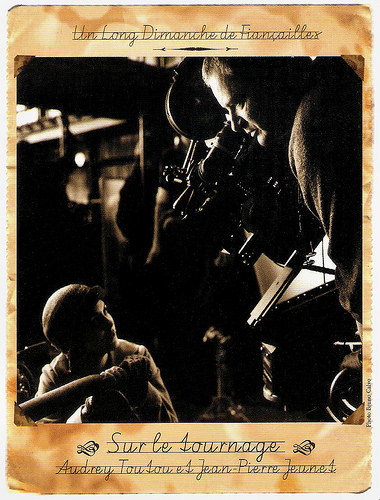
French postcard by Warner Bros, France / Tapioca Films / TF1 Films Production. Poster by Laurent Lufroy. Photo: Bruno Calvo. Publicity still for Un long dimanche de fiançailles/A Very Long Engagement (Jean-Pierre Jeunet, 2004). Audrey Tautou and director Jean-Pierre Jeunet at the set.
Trailer. Source: Geschiedenis Beleven (YouTube).
Sources: Derek Armstrong (AllMovie), Ralph Michael Stein (IMDb), Wikipedia and IMDb.

French postcard by Warner Bros, France / Tapioca Films / TF1 Films Production. Poster by Laurent Lufroy. Photo: Bruno Calvo. Publicity still for Un long dimanche de fiançailles/A Very Long Engagement (Jean-Pierre Jeunet, 2004) with Audrey Tautou as Mathilde.
Manech's Marrying Mathilde
Un long dimanche de fiançailles/A Very Long Engagement (2004) tells the romantic story of Mathilde (Audrey Tautou), a young woman who relentless searches for her fiance Manech (Gaspard Ulliel) during World War I.
Near the Somme, five French soldiers are convicted of self-mutilation in order to escape military service. They are condemned to face near certain death in the no man's land between the French and German trench lines. It appears that all of them were killed in a subsequent battle.
Mathilde, the fiancee of one of the soldiers, refuses to give up hope and begins to uncover clues as to what actually took place on the battlefield. Her task is not made any easier for her due to a bout with polio as a child. She is all the while driven by the constant reminder of what her fiance had carved into one of the bells of the church near their home, MMM for Manech's Marrying Mathilde (actually in French: Manech aime Mathilde = Manech Loves Mathilde).
With the help of a private investigator, she attempts to find out what happened to her fiance. Along the way, she discovers the brutally corrupt system used by the French government to deal with those who tried to escape the front. She also discovers the stories of the other men who were sentenced to the no man's land as a punishment.
The story is told both from the point of view of the fiancee in Paris and the French countryside—mostly Brittany—of the 1920s, and through flashbacks to the battlefield.
Eventually Mathilde finds out her fiance is alive, but he suffers from amnesia. He fails to identify even his adoptive mother. Seeing Mathilde, Manech seems to be oblivious of her. However, he still expresses concern for her when he notices her polio stricken legs, asking her "does it hurt when you walk ?" as he did when they first met. At this, Mathilde sits on the garden chair silently watching Manech with tears in her eyes and a smile on her lips.

French postcard by Warner Bros, France / Tapioca Films / TF1 Films Production. Poster by Laurent Lufroy. Photo: Bruno Calvo. Publicity still for Un long dimanche de fiançailles/A Very Long Engagement (Jean-Pierre Jeunet, 2004) with Gaspard Ulliel as Manech.

French postcard by Warner Bros, France / Tapioca Films / TF1 Films Production. Poster by Laurent Lufroy. Photo: Bruno Calvo. Publicity still for Un long dimanche de fiançailles/A Very Long Engagement (Jean-Pierre Jeunet, 2004) with Jean-Paul Rouve as the mailman.
A visual tour de force
Director Jean-Pierre Jeunet had a surprise smash with Amélie (2001), featuring the expressive Audrey Tatou as a whimsical and charming girl-woman in search of love. In his follow-up film, Un long dimanche de fiancailles, Jeunet crafted a moving, often penetrating drama, set during the darkest days of World War I and its immediate aftermath.
Audrey Tatou returned and plays pretty but frail Mathilde, a loner separated from her peers by her disability. She becomes closest friends with Maneche, the son of a lighthouse keeper. Late adolescence brings love and lust, commitment and an engagement. And when Maneche does not return from the war, Mathilde searches fervently for him, steely faithful in a moving and believable way.
Ralph Michael Stein at IMDb : "her search takes her to cities and battlefields. With resort to a child's employment of magical thinking she frequently whispers tests about what will happen in immediate, ordinary circumstances with one result 'proving' for her that Manech is still alive. Tatou makes this self-deception appealing and infinitely sad."
At AllMovie , Derek Armstrong reviews: "Jean-Pierre Jeunet's most sophisticated achievement to date, if not actually his best film, A Very Long Engagement marks the first instance of the director's trademark techniques applied to a story of historical consequence. In addition to possessing Jeunet's usual busy narration and array of interconnected characters, it's also a visual tour de force."
Un long dimanche de fiancailles was nominated for the Academy Award for Best Art Direction and the Academy Award for Best Cinematography at the Oscars. The film received five Césars, the French equivalent of the Oscar. Marion Cotillard won the César Award for Best Supporting Actress and Gaspard Ulliel the César for Most Promising Actor.

French postcard by Warner Bros, France / Tapioca Films / TF1 Films Production. Poster by Laurent Lufroy. Photo: Bruno Calvo. Publicity still for Un long dimanche de fiançailles/A Very Long Engagement (Jean-Pierre Jeunet, 2004). Audrey Tautou and director Jean-Pierre Jeunet at the set.
Trailer. Source: Geschiedenis Beleven (YouTube).
Sources: Derek Armstrong (AllMovie), Ralph Michael Stein (IMDb), Wikipedia and IMDb.
Published on November 24, 2015 22:00
November 23, 2015
Willy Fritsch
From the middle of the 1920s on, charming Willy Fritsch (1901-1973) replaced Bruno Kastner and Harry Liedtke as the darling of the female cinema goers in Germany. Fritsch became the immensely popular ‘Sunny Boy’ of the Ufa operettas of the 1930s and 1940s, and with his frequent co-star Lilian Harvey he formed the 'dream team of the German cinema'.

German postcard by Ross Verlag, no. 5504/1. Photo: Ufa.

German postcard by Ross Verlag, no. 7870/2, 1932-1933. Photo: Ufa.
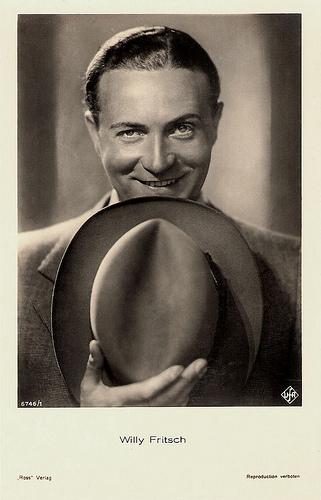
German postcard by Ross Verlag, no. 6746/1, 1931-1932. Photo: Ufa.

German postcard by Ross Verlag, no. 8469/1, 1933-1934. Photo: Ufa / Frhr. von Gudenberg.

German postcard by Ross Verlag, no. 8473/3, 1933-1934. Photo: Ufa / Frhr. von Gudenberg.

German postcard by Ross Verlag, no. 6418/2, 1931-1932. Photo: Atelier Binder, Berlin / Ufa.
Sunny Nature
Willy (sometimes credited as Willi) Fritsch was born as Wilhelm Egon Fritz Fritsch in Kattowitz in German Silesia (now Katowice, Poland), in 1901. He was the son of Lothar Fritsch, a farmer and machine manufacturer, and his wife Anni (née Bauckmann).
In 1912 he moved with his family to Berlin, where he planned to become a mechanic. In 1919 he took up acting lessons from the actor Gustav Sczimek.
Fritsch debuted with a small role at Max Reinhardt's famous Deutsches Theater. There and at the affiliated Kammerspiele (Chamber theatre) he was cast in smaller stage roles, and played young lovers and comic parts. In 1922, he joined the Max Reinhardt Ensemble on its tour through Scandinavia.
From 1921 on, Fritsch began to appear as a supporting player in films, like the sound experiment Miss Venus (Ludwig Czerny, 1921).
In 1923, he auditioned for the leading role of a blind artist in the melodrama Seine Frau, die Unbekannte/His Mysterious Adventure (Benjamin Christensen, 1923), which was then re-written in order to fit his rather sunny nature.
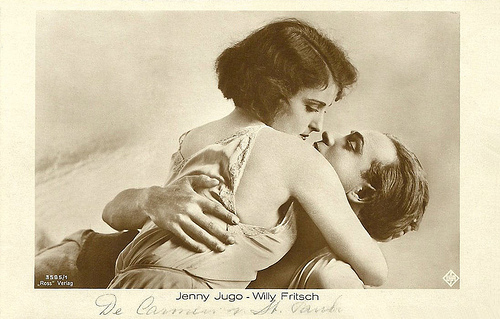
German postcard by Ross Verlag, no. 3585/1. Photo: Jenny Jugo and Willy Fritsch in Die Carmen von St. Pauli/Docks of Hamburg (Erich Waschneck, 1928).

German postcard by Ross Verlag, no. 3586/1. Photo: Ufa.
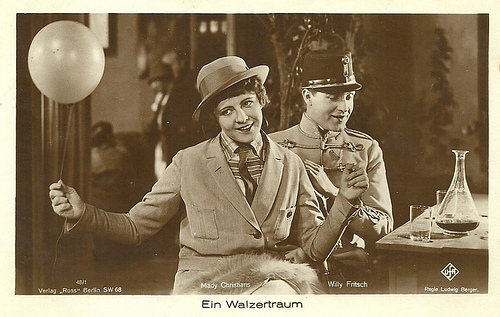
German postcard by Ross Verlag, no. 48/1. Photo: Ufa. Mady Christians and Willy Fritsch in Ein Walzertraum/The Waltz Dream (Ludwig Berger, 1925), based on the Oscar Strauss operetta.
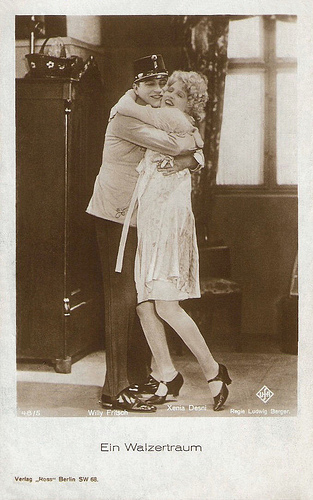
German postcard by Ross Verlag, no. 48/5. Photo: Ufa. Xenia Desni and Willy Fritsch in the German silent film Ein Walzertraum/The Waltz Dream (Ludwig Berger, 1925).

Austrian postcard by Iris Verlag, no. 978. Photo: Eichberg Film / Verleih E. Welt & Co. Publicity still for Die keusche Susanne/The Innocent Susanne (Richard Eichberg, 1926), one of the rare Eichberg productions in which Fritsch played.
Fritz Lang
Willy Fritsch convincingly played the would-be son of an aristocrat in Der Farmer aus Texas/The Farmer from Texas (Joe May, 1925), which made him the new star of the production company Ufa.
Next he starred as the dashing Lieutenant Niki in Ein Walzertraum/A Waltz-Dream (Ludwig Berger, 1925), which turned out to be a significant success in the USA. At AllMovie , Janiss Garza writes: "This UFA silent, based on an old operetta, is far more light-hearted and spirited than the moody, heavy-handed fare that generally came out of Germany."
Ufa intervened when United Artists offered Fritsch a contract. His next films, Der Prinz und die Tänzerin/The Prince and the Dancer (Richard Eichberg, 1926) and Der letzte Walzer/The Last Waltz (Arthur Robison, 1927) basically followed the formula of Ein Walzertraum.
Fritsch only occasionally altered his now well-established film image in Spione/Spies (1928) and Frau im Mond/Woman in the Moon (1929), both directed by Fritz Lang.
Hal Erickson notes at AllMovie : "Spies (Spione) was the first independent production of German 'thriller' director Fritz Lang. The years-ahead-of-its-time plotline involves Russian espionage activity in London. The mastermind is Haghi ( Rudolph Klein-Rogge ), a supposedly respectable carnival sideshow entertainer. Heading the good guys is Agent 326 (Willy Fritsch), with the help of defecting Russian spy Sonya ( Gerda Maurus ). The film moves swiftly to several potential climaxes, each one more exciting than its predecessor. Haghi's ultimate demise is a superbly staged Pirandellian vignette. Anticipating Citizen Kane by a dozen years, director Lang dispenses with all transitional dissolves and fade-outs, flat-cutting territory from one scene to another."

German postcard by Ross Verlag, no. 104/2. Photo: Ufa. Publicity still for Ungarische Rhapsodie/Hungarian Rhapsody (Hanns Schwarz, 1928).
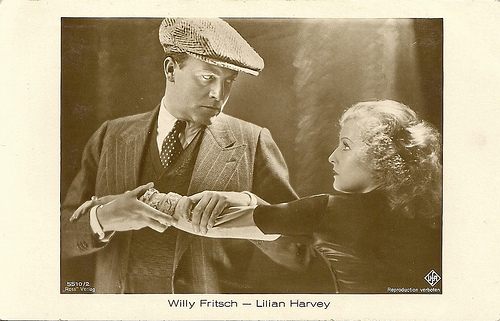
German postcard by Ross Verlag, no. 5510/2, 1930-1931. Photo: Ufa. Publicity still for the early sound film Einbrecher/Burglar (Hanns Schwarz, 1930), in which Fritsch is a burglar who gets an affair with a rich and neglected industrial's wife ( Lilian Harvey ).

German postcard by Ross Verlag, no. 5858/2, 1930-1931. Photo: Ufa. Publicity still for Im Geheimdienst/In the Employ of the Secret Service (Gustav Ucicky, 1931).

German postcard by Ross Verlag, no. 5858/4, 1930-1931. Photo: Ufa. Publicity still for Im Geheimdienst/In Secret Service (Gustav von Ucicky, 1931), a spy film set in Russia in World War One.

German postcard by Ross Verlag, no. 6048/1, 1931. Photo: Ufa Willy Fritsch as the Russian czar Alexander I and his double, in Der Kongress tanzt (Erik Charell, 1931).

German postcard by Ross Verlag, no. 131/6. Photo: Ufa. Still with Lilian Harvey and Willy Fritsch in Der Kongress tanzt/The Congress dances (Erik Charell, 1931). Erich Pommer-Produktion, Ufa.
Lilian Harvey
Willy Fritsch took singing lessons in order to prepare himself for the sound film Melodie des Herzens/Melody of the Heart (Hanns Schwarz, 1929) with Dita Parlo .
His breakthrough came after being paired with Lilian Harvey in Liebeswalzer/The Love Waltz (Wilhelm Thiele, 1930) and the two were also engaged privately. Liebeswalzer established Harvey and Fritsch as the immensely popular 'dream team of the German cinema'.
Their next films such as Hokuspokus/Hocuspokus (Gustav Ucicky, 1930), the historical romance Der Kongress tanzt/Congress Dances (Erik Charell, 1931), Ein blonder Traum/A Blonde's Dream (Paul Martin, 1932) - co-written by Billy Wilder, and especially Die Drei von der Tankstelle/Three Good Friends (Wilhelm Thiele, 1930), were huge international box-office hits.
Fritsch and Harvey appeared together in twelve films. Each of these films featured several songs, which became popular hits and were also released on records, and thereby further added to the popularity of the two stars.
Hal Erickson at AllMovie : "If a poll had ever been conducted amongst fans of international musical-comedy star Lillian Harvey , the actress's most popular vehicle would probably have been Die Drei von Der Tankstelle (Three From the Gas Station) - with Congress Dances running a very close second. The story opens as three debt-ridden young men pool what is left of their savings to open a roadside service station. Their most frequent customer is the wealthy, winsome Ms. Harvey, who frequently shows up fetchingly clad in hiking shorts. Each of the young men falls in love with the girl, unbeknownst to the other two. Which one will she choose? Most likely, the one who sings the best - and that would be Lillian Harvey 's frequent screen vis-a-vis Willy Fritsch."
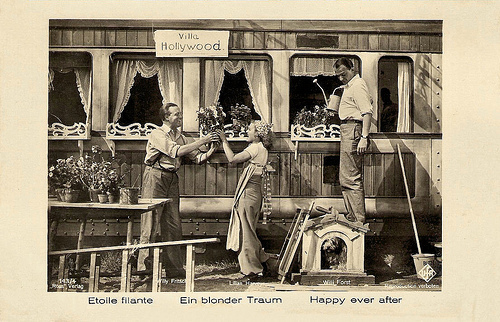
German postcard by Ross Verlag, no. 143/4. Photo: Ufa. Publicity still of Willy Fritsch, Lilian Harvey and Willi Forst in the musical comedy Ein blonder Traum/Happy Ever After (Paul Martin, 1932).

German postcard by Ross Verlag, no. 192/2, 1932-1933. Photo: Ufa. Publicity still for Walzerkrieg/Waltz Time in Vienna (Ludwig Berger, 1933). Collection: Egbert Barten.
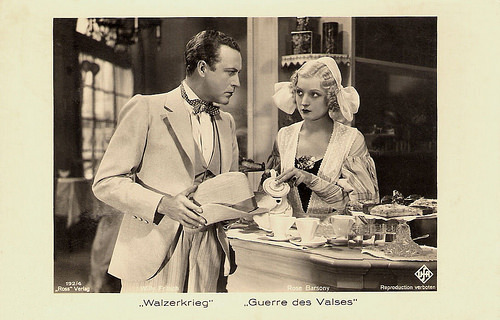
German postcard by Ross Verlag, no. 192/4. Photo: Ufa. Publicity still for Walzerkrieg (Ludwig Berger, 1933) with Rose Barsony .

German postcard by Ross Verlag, no. 8300/1, 1933-1934. Photo: Ufa. Willy Fritsch as Fürst Leopold von Anhalt-Dessau in Des jungen Dessauers grosse Liebe (Arthur Robison, 1933).
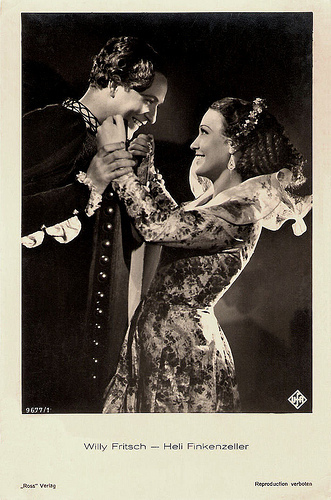
German postcard by Ross Verlag, no. 9677/1, 1935 - 1936. Photo: Ufa. Publicity still for Boccaccio (Herbert Maisch, 1936) with Heli Finkenzeller .

German postcard by Film-Foto-Verlag, no. A 3844/1, 1941-1944. Photo: Baumann / Ufa. From Tatiana.
Character Actor
Willy Fritsch had a long-term contract with Ufa and was paid a monthly salary of 20.000 Reichsmark per month, which was doubled during the 1930s.
Eschewing his trademark sunny boy persona, Fritsch proved his range as a character actor in films like Ich bei Tag und Du bei Nacht/I by Day, You by Night (Ludwig Berger, 1932) co-starring Käthe von Nagy , Walzerkrieg/The Battle of the Walzes (Ludwig Berger, 1933) opposite Renate Müller , and the satirical romp Amphitryon/Amphitryon - Happiness from the Clouds (Reinhold Schünzel, 1935) with Paul Kemp .
Fritsch managed to survive the Hitler era without any loss of prestige. After the end of the war, he relocated to Hamburg. He spoofed his own image as the romantic lover in Film ohne Titel/Film Without a Title (Rudolf Jugert, 1947), and excelled as the comical conférencier in Herrliche Zeiten/Fun Times (Erik Ode, Günter Neumann, 1949).
Although still in high demand, Fritsch didn't find satisfying roles in West-Germany's post-war cinema. He continued to appear on stage and in films until the early 1960s. He remained a popular figure, partly due to his work as the host of nostalgic radio shows.
Since 1937, he was married to dancer and actress Dinah Grace until her death in 1963. They had two sons, Michael and Thomas. After his wife's death he decided to retire.
With his son Thomas Fritsch he starred in his final film, Das hab ich von Papa gelernt/I Learned It from Daddy (Axel von Ambesser, 1964). In 1963 he had published his memoir … das kommt nicht wieder/That will never come back, and in 1965 he was honoured with the Filmband in Gold, for his long and important work for the German film.
Willy Fritsch died of heart failure in 1973 in Hamburg, Germany. He was 72.
Scenes with Willy Fritsch and Lilian Harvey in Die keusche Susanne/The Innocent Susanne (1926), the silent film in which they first appeared together. Source: SittichFan (YouTube).
Willy Fritsch tells Lilian Harvey that she is too good for an afternoon love affair with Heinz Rühmann in Einbrecher (1930). Source: Taylormayes (YouTube).
Scene from Einbrecher (1930) with Willy Fritsch, Lilian Harvey, Heinz Rühmann and Kurt Gerron. He sings: Ich lass mir meinen Körper schwarz bepinseln. Composer: Friedrich Holländer. Source: SittichFan (YouTube).
Willy Fritsch sings the title song in Wenn der weisse Flieder wieder blüht/When the White Lilacs Bloom Again (Hans Deppe, 1953) with Magda Schneider and Romy Schneider. Source: fritz51213 (YouTube).
Willy and Thomas Fritsch in Das hab ich von Papa gelernt (1964). Source: SittichFan (YouTube).
Sources: Filmportal.de, Stephanie D'heil (Steffi-line - German), Thomas Staedeli (Cyranos), Hal Erickson (AllMovie), and Wikipedia.

German postcard by Ross Verlag, no. 5504/1. Photo: Ufa.

German postcard by Ross Verlag, no. 7870/2, 1932-1933. Photo: Ufa.

German postcard by Ross Verlag, no. 6746/1, 1931-1932. Photo: Ufa.

German postcard by Ross Verlag, no. 8469/1, 1933-1934. Photo: Ufa / Frhr. von Gudenberg.

German postcard by Ross Verlag, no. 8473/3, 1933-1934. Photo: Ufa / Frhr. von Gudenberg.

German postcard by Ross Verlag, no. 6418/2, 1931-1932. Photo: Atelier Binder, Berlin / Ufa.
Sunny Nature
Willy (sometimes credited as Willi) Fritsch was born as Wilhelm Egon Fritz Fritsch in Kattowitz in German Silesia (now Katowice, Poland), in 1901. He was the son of Lothar Fritsch, a farmer and machine manufacturer, and his wife Anni (née Bauckmann).
In 1912 he moved with his family to Berlin, where he planned to become a mechanic. In 1919 he took up acting lessons from the actor Gustav Sczimek.
Fritsch debuted with a small role at Max Reinhardt's famous Deutsches Theater. There and at the affiliated Kammerspiele (Chamber theatre) he was cast in smaller stage roles, and played young lovers and comic parts. In 1922, he joined the Max Reinhardt Ensemble on its tour through Scandinavia.
From 1921 on, Fritsch began to appear as a supporting player in films, like the sound experiment Miss Venus (Ludwig Czerny, 1921).
In 1923, he auditioned for the leading role of a blind artist in the melodrama Seine Frau, die Unbekannte/His Mysterious Adventure (Benjamin Christensen, 1923), which was then re-written in order to fit his rather sunny nature.

German postcard by Ross Verlag, no. 3585/1. Photo: Jenny Jugo and Willy Fritsch in Die Carmen von St. Pauli/Docks of Hamburg (Erich Waschneck, 1928).

German postcard by Ross Verlag, no. 3586/1. Photo: Ufa.

German postcard by Ross Verlag, no. 48/1. Photo: Ufa. Mady Christians and Willy Fritsch in Ein Walzertraum/The Waltz Dream (Ludwig Berger, 1925), based on the Oscar Strauss operetta.

German postcard by Ross Verlag, no. 48/5. Photo: Ufa. Xenia Desni and Willy Fritsch in the German silent film Ein Walzertraum/The Waltz Dream (Ludwig Berger, 1925).

Austrian postcard by Iris Verlag, no. 978. Photo: Eichberg Film / Verleih E. Welt & Co. Publicity still for Die keusche Susanne/The Innocent Susanne (Richard Eichberg, 1926), one of the rare Eichberg productions in which Fritsch played.
Fritz Lang
Willy Fritsch convincingly played the would-be son of an aristocrat in Der Farmer aus Texas/The Farmer from Texas (Joe May, 1925), which made him the new star of the production company Ufa.
Next he starred as the dashing Lieutenant Niki in Ein Walzertraum/A Waltz-Dream (Ludwig Berger, 1925), which turned out to be a significant success in the USA. At AllMovie , Janiss Garza writes: "This UFA silent, based on an old operetta, is far more light-hearted and spirited than the moody, heavy-handed fare that generally came out of Germany."
Ufa intervened when United Artists offered Fritsch a contract. His next films, Der Prinz und die Tänzerin/The Prince and the Dancer (Richard Eichberg, 1926) and Der letzte Walzer/The Last Waltz (Arthur Robison, 1927) basically followed the formula of Ein Walzertraum.
Fritsch only occasionally altered his now well-established film image in Spione/Spies (1928) and Frau im Mond/Woman in the Moon (1929), both directed by Fritz Lang.
Hal Erickson notes at AllMovie : "Spies (Spione) was the first independent production of German 'thriller' director Fritz Lang. The years-ahead-of-its-time plotline involves Russian espionage activity in London. The mastermind is Haghi ( Rudolph Klein-Rogge ), a supposedly respectable carnival sideshow entertainer. Heading the good guys is Agent 326 (Willy Fritsch), with the help of defecting Russian spy Sonya ( Gerda Maurus ). The film moves swiftly to several potential climaxes, each one more exciting than its predecessor. Haghi's ultimate demise is a superbly staged Pirandellian vignette. Anticipating Citizen Kane by a dozen years, director Lang dispenses with all transitional dissolves and fade-outs, flat-cutting territory from one scene to another."

German postcard by Ross Verlag, no. 104/2. Photo: Ufa. Publicity still for Ungarische Rhapsodie/Hungarian Rhapsody (Hanns Schwarz, 1928).

German postcard by Ross Verlag, no. 5510/2, 1930-1931. Photo: Ufa. Publicity still for the early sound film Einbrecher/Burglar (Hanns Schwarz, 1930), in which Fritsch is a burglar who gets an affair with a rich and neglected industrial's wife ( Lilian Harvey ).

German postcard by Ross Verlag, no. 5858/2, 1930-1931. Photo: Ufa. Publicity still for Im Geheimdienst/In the Employ of the Secret Service (Gustav Ucicky, 1931).

German postcard by Ross Verlag, no. 5858/4, 1930-1931. Photo: Ufa. Publicity still for Im Geheimdienst/In Secret Service (Gustav von Ucicky, 1931), a spy film set in Russia in World War One.

German postcard by Ross Verlag, no. 6048/1, 1931. Photo: Ufa Willy Fritsch as the Russian czar Alexander I and his double, in Der Kongress tanzt (Erik Charell, 1931).

German postcard by Ross Verlag, no. 131/6. Photo: Ufa. Still with Lilian Harvey and Willy Fritsch in Der Kongress tanzt/The Congress dances (Erik Charell, 1931). Erich Pommer-Produktion, Ufa.
Lilian Harvey
Willy Fritsch took singing lessons in order to prepare himself for the sound film Melodie des Herzens/Melody of the Heart (Hanns Schwarz, 1929) with Dita Parlo .
His breakthrough came after being paired with Lilian Harvey in Liebeswalzer/The Love Waltz (Wilhelm Thiele, 1930) and the two were also engaged privately. Liebeswalzer established Harvey and Fritsch as the immensely popular 'dream team of the German cinema'.
Their next films such as Hokuspokus/Hocuspokus (Gustav Ucicky, 1930), the historical romance Der Kongress tanzt/Congress Dances (Erik Charell, 1931), Ein blonder Traum/A Blonde's Dream (Paul Martin, 1932) - co-written by Billy Wilder, and especially Die Drei von der Tankstelle/Three Good Friends (Wilhelm Thiele, 1930), were huge international box-office hits.
Fritsch and Harvey appeared together in twelve films. Each of these films featured several songs, which became popular hits and were also released on records, and thereby further added to the popularity of the two stars.
Hal Erickson at AllMovie : "If a poll had ever been conducted amongst fans of international musical-comedy star Lillian Harvey , the actress's most popular vehicle would probably have been Die Drei von Der Tankstelle (Three From the Gas Station) - with Congress Dances running a very close second. The story opens as three debt-ridden young men pool what is left of their savings to open a roadside service station. Their most frequent customer is the wealthy, winsome Ms. Harvey, who frequently shows up fetchingly clad in hiking shorts. Each of the young men falls in love with the girl, unbeknownst to the other two. Which one will she choose? Most likely, the one who sings the best - and that would be Lillian Harvey 's frequent screen vis-a-vis Willy Fritsch."

German postcard by Ross Verlag, no. 143/4. Photo: Ufa. Publicity still of Willy Fritsch, Lilian Harvey and Willi Forst in the musical comedy Ein blonder Traum/Happy Ever After (Paul Martin, 1932).

German postcard by Ross Verlag, no. 192/2, 1932-1933. Photo: Ufa. Publicity still for Walzerkrieg/Waltz Time in Vienna (Ludwig Berger, 1933). Collection: Egbert Barten.

German postcard by Ross Verlag, no. 192/4. Photo: Ufa. Publicity still for Walzerkrieg (Ludwig Berger, 1933) with Rose Barsony .

German postcard by Ross Verlag, no. 8300/1, 1933-1934. Photo: Ufa. Willy Fritsch as Fürst Leopold von Anhalt-Dessau in Des jungen Dessauers grosse Liebe (Arthur Robison, 1933).

German postcard by Ross Verlag, no. 9677/1, 1935 - 1936. Photo: Ufa. Publicity still for Boccaccio (Herbert Maisch, 1936) with Heli Finkenzeller .

German postcard by Film-Foto-Verlag, no. A 3844/1, 1941-1944. Photo: Baumann / Ufa. From Tatiana.
Character Actor
Willy Fritsch had a long-term contract with Ufa and was paid a monthly salary of 20.000 Reichsmark per month, which was doubled during the 1930s.
Eschewing his trademark sunny boy persona, Fritsch proved his range as a character actor in films like Ich bei Tag und Du bei Nacht/I by Day, You by Night (Ludwig Berger, 1932) co-starring Käthe von Nagy , Walzerkrieg/The Battle of the Walzes (Ludwig Berger, 1933) opposite Renate Müller , and the satirical romp Amphitryon/Amphitryon - Happiness from the Clouds (Reinhold Schünzel, 1935) with Paul Kemp .
Fritsch managed to survive the Hitler era without any loss of prestige. After the end of the war, he relocated to Hamburg. He spoofed his own image as the romantic lover in Film ohne Titel/Film Without a Title (Rudolf Jugert, 1947), and excelled as the comical conférencier in Herrliche Zeiten/Fun Times (Erik Ode, Günter Neumann, 1949).
Although still in high demand, Fritsch didn't find satisfying roles in West-Germany's post-war cinema. He continued to appear on stage and in films until the early 1960s. He remained a popular figure, partly due to his work as the host of nostalgic radio shows.
Since 1937, he was married to dancer and actress Dinah Grace until her death in 1963. They had two sons, Michael and Thomas. After his wife's death he decided to retire.
With his son Thomas Fritsch he starred in his final film, Das hab ich von Papa gelernt/I Learned It from Daddy (Axel von Ambesser, 1964). In 1963 he had published his memoir … das kommt nicht wieder/That will never come back, and in 1965 he was honoured with the Filmband in Gold, for his long and important work for the German film.
Willy Fritsch died of heart failure in 1973 in Hamburg, Germany. He was 72.
Scenes with Willy Fritsch and Lilian Harvey in Die keusche Susanne/The Innocent Susanne (1926), the silent film in which they first appeared together. Source: SittichFan (YouTube).
Willy Fritsch tells Lilian Harvey that she is too good for an afternoon love affair with Heinz Rühmann in Einbrecher (1930). Source: Taylormayes (YouTube).
Scene from Einbrecher (1930) with Willy Fritsch, Lilian Harvey, Heinz Rühmann and Kurt Gerron. He sings: Ich lass mir meinen Körper schwarz bepinseln. Composer: Friedrich Holländer. Source: SittichFan (YouTube).
Willy Fritsch sings the title song in Wenn der weisse Flieder wieder blüht/When the White Lilacs Bloom Again (Hans Deppe, 1953) with Magda Schneider and Romy Schneider. Source: fritz51213 (YouTube).
Willy and Thomas Fritsch in Das hab ich von Papa gelernt (1964). Source: SittichFan (YouTube).
Sources: Filmportal.de, Stephanie D'heil (Steffi-line - German), Thomas Staedeli (Cyranos), Hal Erickson (AllMovie), and Wikipedia.
Published on November 23, 2015 22:00
November 22, 2015
Geneviève Félix
Geneviève Félix (1901-?) was a French actress who had a brief but successful career in the silent cinema. After being a regular actress of Georges Champavert and Jean Kemm, she starred in the Victor Hugo adaptation La dame de Monsoreau (1925).

French postcard by Cinémagazine-Edition, no. 12.
Muse of Montmartre
Geneviève Félix was born in Paris in 1901. In her teens she was crowned Muse de Montmartre, a kind of beauty queen contest linked to French nationalism and republicanism. This probably gave her an introduction to the cinema.
In 1917 she debuted in the film Le ballon rouge/The Red Balloon, in which she played with Charles Lamy. She also appeared in a short production by the Eclipse company, La phalène bleue/The blue phalène (Georges Champavert, 1917).
Georges Champavert became her regular director in the late 1910s and their films include L’oeil de Saint-Yves/Saint Yves's eye (1919), Les deux jarretières/Both garters (1919), and Le passé renait/The Past Returns (1919). She also appeared in La chimère/The fancy (Lucien Lehmann, 1919) with Edmond Van Daële, and L’engrenage/The gearing (Louis Feuillade, 1919) with René Cresté .
In the early 1920s, Félix became the favourite actress of director Jean Kemm, who directed her in Miss Rovel (1920), Micheline (1921), La ferme du choquart/The farm of Voquart (1921), Hantise/Obsession (1922), and L’absolution/The forgiveness (1922) with Pierre Blanchard . In 1923 Félix had become such a celebrated star that she was hired to endorse Crème Simon, a French heritage skincare brand founded by Joseph Simon in 1860.
In the mid-1920s, Félix played in various films by Georges Monca and Maurice Kéroul, such as L’ironie du sort/The irony of fate (Georges Monca, 1924), the Austrian film Die Geliebte des Mörders/The Lover of the Murderer (Maurice Kéroul, Max Reichmann, 1923), the crime film La double existence de Lord Samsey/The double existence of Lord Samsey (Maurice Kéroul, Georges Monca, 1924) in which Félix played the Lord in travesty, Altemer le cynique/Altemer, the Cynic (Georges Monca, 1924), Autour d’un berceau/Around a cradle (Maurice Kéroul, Georges Monca, 1924), and a remake of Louis Feuillade’s L’engrenage/The gearing (1925), this time directed by Kéroul and Reichmann.

French postcard by Cinémagazine, no. 97.

French postcard by A.N., Paris. In the series Les Vedettes de Cinéma, no. 42.
Innocently imprisoned for murder
In 1924 Geneviève Félix played in the four-part crime serial La porteuse de pain/The Bread Peddler (René Le Somptier, 1924), starring Suzanne Desprès as Jeanne. Félix played Jeanne's daughter Lucie, who has been innocently imprisoned for murder, evaded and has become bread peddler. Lucien (Jacques Guilhène), son of the victim, loves Lucie, ignoring her identity, while Mary, the daughter of the real murderer ( Germaine Rouer ), has set her eyes on Lucien.
Obviously, director Le Somptier liked Félix, because she got the lead in his subsequent film, the prestigious production La dame de Monsoreau/The Lady of Monsoreau (René Le Somptier, 1925), adapted from Victor Hugo’s novel. Félix plays Diane de Meridor, who is married but has an affair with Louis de Bussy. The story is set against the background of the religious and political factions in the France of king Henry III. Félix’s co-stars in the film were Rolla Norman (Bussy) and Gina Manès (Mme de Saint-Luc).
Félix’ last silent film was Grand-mère/Grandmother (Albert-Francis Bertoni, 1925), starring Sylvio de Pedrelli and child star Régine Dumien . After that Félix was not seen in the cinema for years.
In 1932 she returned with the short sound film Arrêtez-moi/Stop Me! (Christian Matras, Charles-Félix Tavano, 1932), and she had a small part as the mother superior in another Dumas adaptation: Les trois mousquetaires/The Three Musketeers (Henri Diamant-Berger, 1933), which had Aimé Simon-Girard as D’Artagnan and Blanche Montel as Constance.
Here our bio stops. We could not find any information on internet about Geneviève Félix’s whereabouts after the early 1930s, nor the date or place of her death. If you've more information, please let us know.

French postcard by Cinémagazine-Edition, Paris, no. 234. Poto: Studio G.L. Manuel Frères.

French postcard by Editions La Fayette in the Nos artistes dans leur loge series, no. 107. Photo Comoedia.
Sources: Jean-Pascal Constantin (Les Gens du Cinéma - French), Wikipedia (French and English) and .

French postcard by Cinémagazine-Edition, no. 12.
Muse of Montmartre
Geneviève Félix was born in Paris in 1901. In her teens she was crowned Muse de Montmartre, a kind of beauty queen contest linked to French nationalism and republicanism. This probably gave her an introduction to the cinema.
In 1917 she debuted in the film Le ballon rouge/The Red Balloon, in which she played with Charles Lamy. She also appeared in a short production by the Eclipse company, La phalène bleue/The blue phalène (Georges Champavert, 1917).
Georges Champavert became her regular director in the late 1910s and their films include L’oeil de Saint-Yves/Saint Yves's eye (1919), Les deux jarretières/Both garters (1919), and Le passé renait/The Past Returns (1919). She also appeared in La chimère/The fancy (Lucien Lehmann, 1919) with Edmond Van Daële, and L’engrenage/The gearing (Louis Feuillade, 1919) with René Cresté .
In the early 1920s, Félix became the favourite actress of director Jean Kemm, who directed her in Miss Rovel (1920), Micheline (1921), La ferme du choquart/The farm of Voquart (1921), Hantise/Obsession (1922), and L’absolution/The forgiveness (1922) with Pierre Blanchard . In 1923 Félix had become such a celebrated star that she was hired to endorse Crème Simon, a French heritage skincare brand founded by Joseph Simon in 1860.
In the mid-1920s, Félix played in various films by Georges Monca and Maurice Kéroul, such as L’ironie du sort/The irony of fate (Georges Monca, 1924), the Austrian film Die Geliebte des Mörders/The Lover of the Murderer (Maurice Kéroul, Max Reichmann, 1923), the crime film La double existence de Lord Samsey/The double existence of Lord Samsey (Maurice Kéroul, Georges Monca, 1924) in which Félix played the Lord in travesty, Altemer le cynique/Altemer, the Cynic (Georges Monca, 1924), Autour d’un berceau/Around a cradle (Maurice Kéroul, Georges Monca, 1924), and a remake of Louis Feuillade’s L’engrenage/The gearing (1925), this time directed by Kéroul and Reichmann.

French postcard by Cinémagazine, no. 97.

French postcard by A.N., Paris. In the series Les Vedettes de Cinéma, no. 42.
Innocently imprisoned for murder
In 1924 Geneviève Félix played in the four-part crime serial La porteuse de pain/The Bread Peddler (René Le Somptier, 1924), starring Suzanne Desprès as Jeanne. Félix played Jeanne's daughter Lucie, who has been innocently imprisoned for murder, evaded and has become bread peddler. Lucien (Jacques Guilhène), son of the victim, loves Lucie, ignoring her identity, while Mary, the daughter of the real murderer ( Germaine Rouer ), has set her eyes on Lucien.
Obviously, director Le Somptier liked Félix, because she got the lead in his subsequent film, the prestigious production La dame de Monsoreau/The Lady of Monsoreau (René Le Somptier, 1925), adapted from Victor Hugo’s novel. Félix plays Diane de Meridor, who is married but has an affair with Louis de Bussy. The story is set against the background of the religious and political factions in the France of king Henry III. Félix’s co-stars in the film were Rolla Norman (Bussy) and Gina Manès (Mme de Saint-Luc).
Félix’ last silent film was Grand-mère/Grandmother (Albert-Francis Bertoni, 1925), starring Sylvio de Pedrelli and child star Régine Dumien . After that Félix was not seen in the cinema for years.
In 1932 she returned with the short sound film Arrêtez-moi/Stop Me! (Christian Matras, Charles-Félix Tavano, 1932), and she had a small part as the mother superior in another Dumas adaptation: Les trois mousquetaires/The Three Musketeers (Henri Diamant-Berger, 1933), which had Aimé Simon-Girard as D’Artagnan and Blanche Montel as Constance.
Here our bio stops. We could not find any information on internet about Geneviève Félix’s whereabouts after the early 1930s, nor the date or place of her death. If you've more information, please let us know.

French postcard by Cinémagazine-Edition, Paris, no. 234. Poto: Studio G.L. Manuel Frères.

French postcard by Editions La Fayette in the Nos artistes dans leur loge series, no. 107. Photo Comoedia.
Sources: Jean-Pascal Constantin (Les Gens du Cinéma - French), Wikipedia (French and English) and .
Published on November 22, 2015 22:00
November 21, 2015
Caterina Valente
Italian singer, dancer and actress Caterina Valente (1931) was in the late 1950s and early 1960s the queen of the German Schlager music. Her popularity was global, and she played and sang in fifteen films. The Guinness Book of World Records recognised her as Europe's most successful female recording artist, with over 1350 albums to her credit.
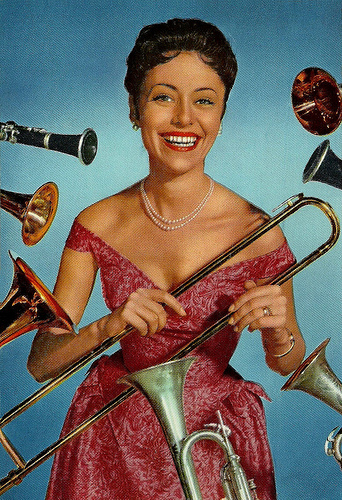
Vintage postcard.
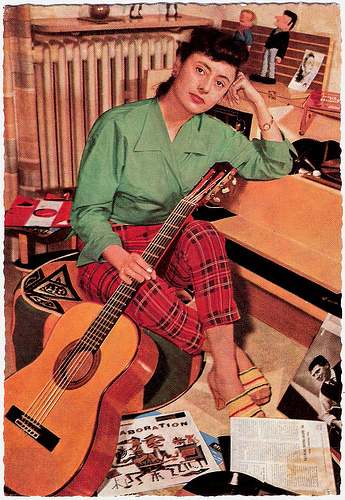
German postcard by WS-Druck, Wanne-Eickel, no. F 23. Photo: Ringpress.
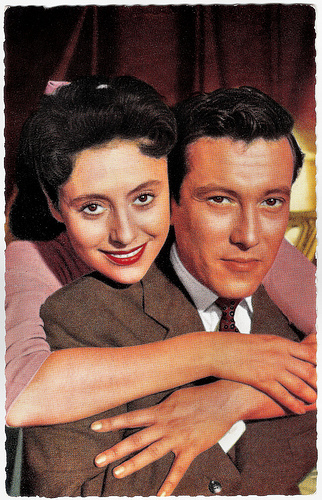
German postcard by Kolibri-Verlag, Minden/Westf., no. F 32. Photo: Ringpress / Vogelmann. Publicity still for Bonjour Kathrin (Karl Anton, 1956) with Dietmar Schönherr .
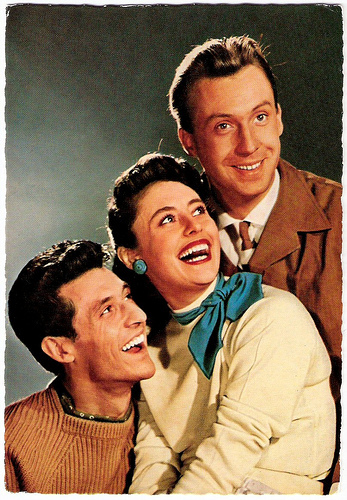
German postcard by WS-Druck, Wanne-Eickel, no. F 73. Photo: Lantin. With Peter Alexander and Silvio Francesco .
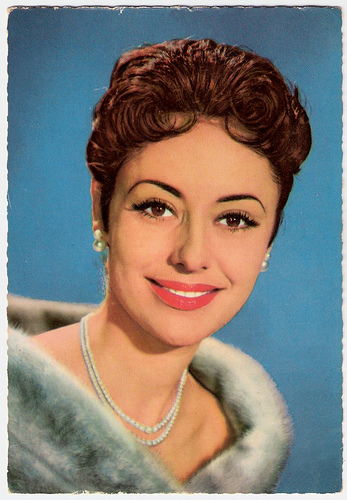
German postcard by ISV, no. L 2. Photo: Klaus Collignon.
Initial Years
Caterina Valente was born in Paris, France, in 1931 in an Italian artist family. Her father Giuseppe Valente was a well-known accordion player, her mother Maria Valente a musical clown. She had three siblings. With her older brother, the late singer and actor Silvio Francesco , she made later many records together, and he would be a frequent guest and musical director in her stage as well as TV-shows.
Caterina started her career as a singer and dancer at the circus Grock. In 1952 she married juggler Erik van Aro who recognised her talent and accompanied her in her initial years of worldwide success. Their son is the singer Eric van Aro, Jr.
A year later, she made her first recordings for Polydor with the orchestra of Kurt Edelhagen. Soon afterwards she achieved great success with songs such as Dreh dich nicht um (Don't Turn Around). Her hit Ganz Paris träumt von der Liebe (1954), based on the Cole Porter song I Love Paris, sold more than 500,000 copies.
After her first musical successes, she sang and danced in the crime film Mannequins für Rio/Party Girls for Sale (Kurt Neumann, 1954) starring Johanna Matz and Raymond Burr. The next year she performed in such German musicals as Ball im Savoy/Ball at Savoy (Paul Martin, 1955), and with Peter Alexander in Liebe, Tanz und 1000 Schlager/Love, Dance, and 1000 Songs (Paul Martin, 1955).

Dutch postcard by Gebr. Spanjersberg N.V., Rotterdam, no. 3928. Photo: Ufa.
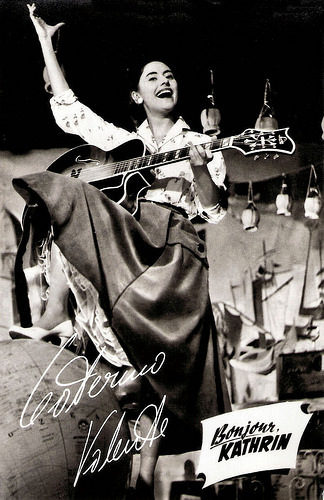
East-German postcard by VEB Progress Film-Vertrieb, no. 175, 1956. Retail price: 0,20 DM. Photo: publicity still for Bonjour, Kathrin (Karl Anton, 1956).
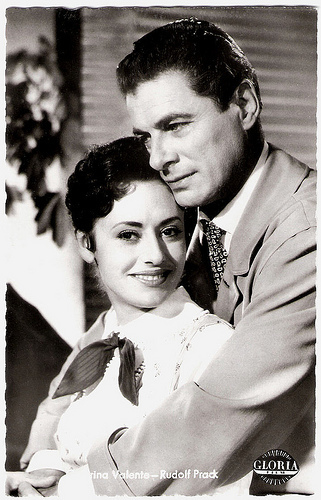
German postcard by Kolibri-Verlag G.m.b.H., Minden/Westf., no. 2952. Photo: CCC / Gloria. Publicity still for Das einfache Mädchen/The simple girl (Werner Jacobs, 1957) with Rudolf Prack .
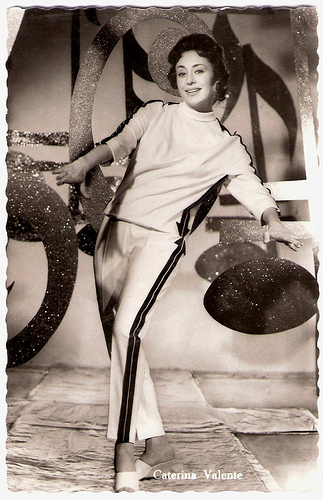
Dutch postcard by N.V. v.h. Weenenk & Snel, Baarn, no. 880. Photo: Hafbo. Publicity still for Hier bin ich, Hier bleib ich/Here I Am, Here I Stay (Werner Jacobs, 1959).
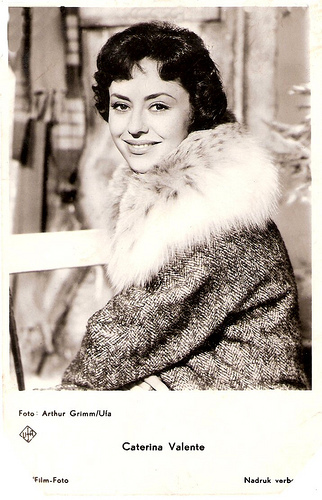
Dutch postcard by Gebr. Spanjersberg N.V., Rotterdam, no. 1159. Photo: Arthur Grimm / Universum-Film Aktiengesellschaft (Ufa), Berlin-Tempelhof.
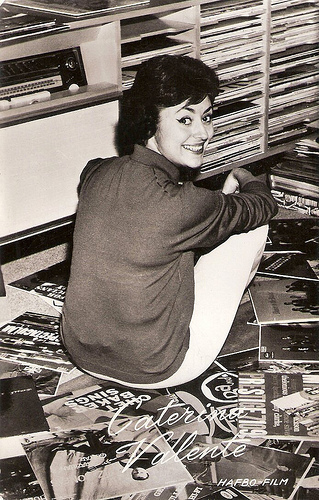
Dutch postcard by Takken, Utrecht, no. AX 4197.
Bossanova Girl
In 1954 and 1955 Caterina Valente had international success with Malagueña. The song which introduced the Bossanova in Europe was written for her by Cuban composer Ernesto Lecuona. It charted first in Europe and eventually in England and the US.
Malaguena was featured on American TV in the Colgate Comedy Hour with Gordon MacRae. Malaguena was followed by Analucia, also written by Lecuona, which when re-released in an English version as The Breeze and I became a top ten hit in both Great Britain and the US.
By this time Valente had become a truly multi-lingual artist, performing her cabaret act and issuing recordings in six languages: French, German, Italian, English, Spanish and Swedish. In France she made the musical Casino de Paris (André Hunebelle, 1957) with Gilbert Bécaud and Vittorio de Sica , and in Germany she continued to make popular Schlagerfilms like Hier bin ich - hier bleib' ich/Here I Am, Here I Stay (Werner Jacobs, 1959) with Hans Holt . In the US she was nominated for a Grammy Award in 1959.
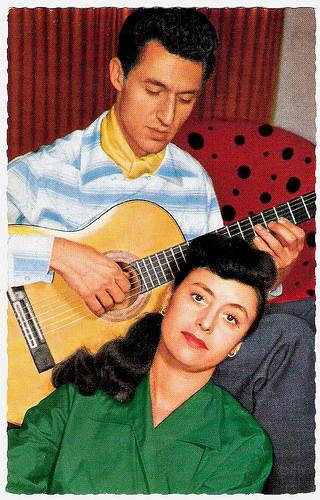
German postcard by Kolibri-Verlag G.m.b.H, Minden (Westf.), no F 31. Photo: Ringpress / Vogelmann. With Silvio Francesco .
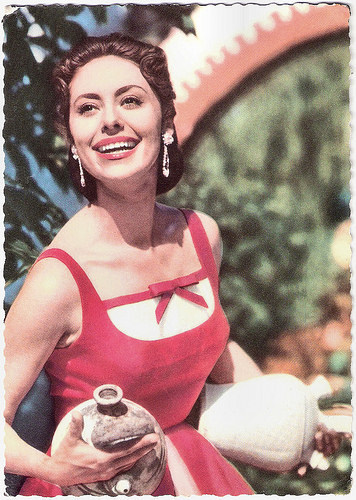
German postcard by Ufa, Berlin-Tempelhof, no. CK-55. Retail price: 30 Pfg. Photo: Arthur Grimm / Ufa.
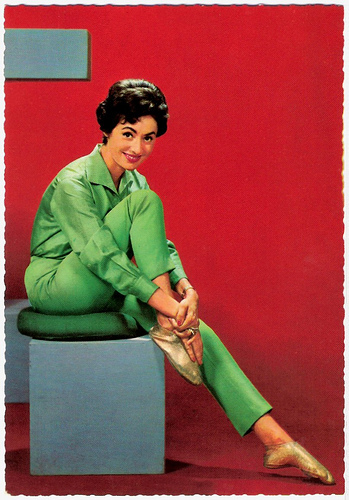
German postcard by Krüger, no. 902/22. Photo: Teldec / Farabola.
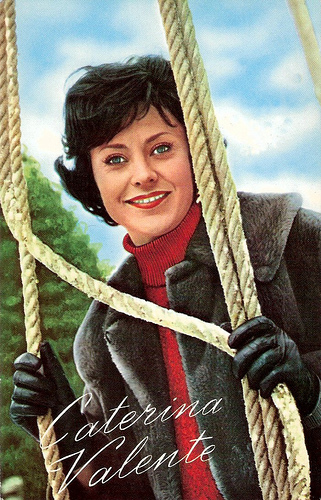
Dutch postcard, mailed in 1964.
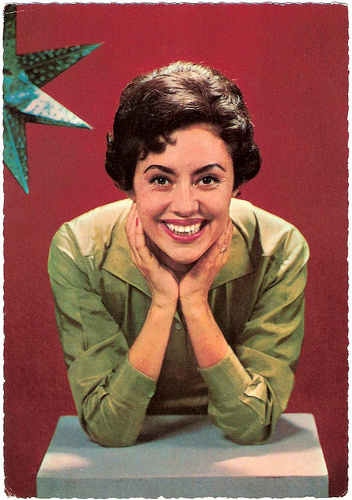
German postcard by Kruger, no. 902/19. Photo: Teldec / Farabola.
Girltalk
During the early 1960s Caterina Valente switched alliances to Decca Records and scored several hits with them, including Itsy Bity Teenie Weenie Honolulu Strand Bikini, and Quando, Quando, Quando. Valente worked with the legendary Claus Ogerman and recorded material in both Italian and English. Her version of La Golondrina appeared on one of the first charity albums, All Star Festival (1963). The proceeds from that album went to aid refugees.
Between 1966 and 1972 she was a frequent guest on the Dean Martin Show and other American TV shows. From the mid 1950s to the 1980s German, Italian, Swiss and Austrian television produced more than a dozen series of Valente-Shows.
Over the years, she has recorded or performed with many international stars, including Louis Armstrong, Benny Goodman, Ella Fitzgerald, Woody Herman, the Tommy Dorsey Orchestra and Chet Baker.
In 1988 she issued Caterina 86, a recording made with the Count Basie Orchestra. In 1986 she enjoyed her fiftieth year on stage jubilee with the German TV show Bravo, Catrin! which attracted 17 million spectators. The Italian jazz CD A briglia sciolta (1989) became Valente’s best selling CD worldwide.
In 2001, she released her latest album of newly recorded material Girltalk, with harpist Catherine Michel. Among her many awards are the German Bundesverdienstkreuz (Cross of merit) (1968) and Großes Bundesverdienstkreuz (Grand Cross of merit) (1985), and the Italian Premio Gabardi (Lifetime Achievement Award) (2004). In 1972, Valente married her musical director, British composer and jazz pianist Roy Budd. They had a son, Alexander Budd, but they divorced in 1979. Today, Caterina Valente lives in her villa at the lake of Lugano in Switzerland.
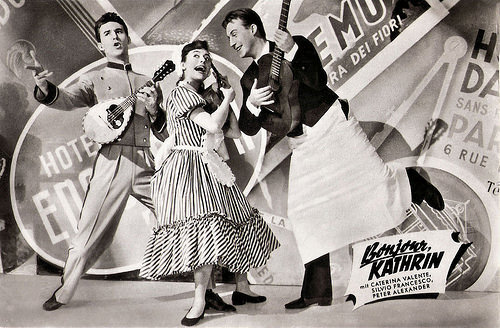
East-German postcard by VEB Progress Film-Vertrieb, no. 164, 1956. Retail price: 0,20 DM. Photo: publicity still for Bonjour, Kathrin (Karl Anton, 1956) with Silvio Francesco and Peter Alexander .
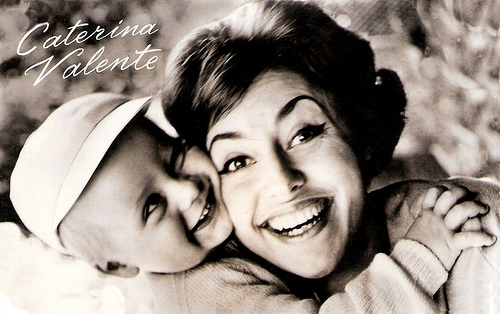
Dutch postcard by Uitg. Takken, Utrecht, no. AX 4198. With her son Eric.
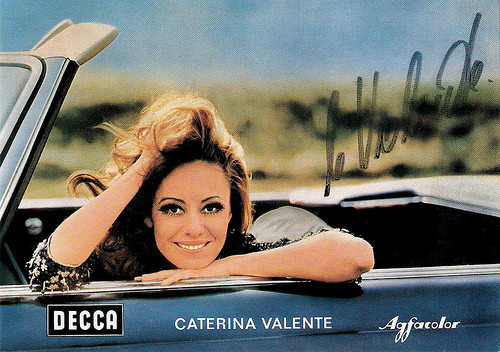
German promotion card by Decca, no. 225.
Caterina Valente and Bully Bulhan sing Schnurri-burri-bum in Die Grosse Starparade 1954 (Paul Martin, 1954). Source: Mr. Steamhammer100 (YouTube).
Young Caterina Valente singing and dancing in Liebe, Tanz und 1000 Schlager (Paul Martin, 1955). Source: SunJohann (YouTube).
Caterina Valente sings Es gibt noch Märchen (There are still fairy tales) in the schlagerfilm Das einfache Mädchen/The Ordinary Girl (Werner Jacobs, 1957). Source: Wyrubowa (YouTube).
Sources: Stacia Proefrock (AllMusic), (IMDb), CaterinaValente.com, Wikipedia, and .

Vintage postcard.

German postcard by WS-Druck, Wanne-Eickel, no. F 23. Photo: Ringpress.

German postcard by Kolibri-Verlag, Minden/Westf., no. F 32. Photo: Ringpress / Vogelmann. Publicity still for Bonjour Kathrin (Karl Anton, 1956) with Dietmar Schönherr .

German postcard by WS-Druck, Wanne-Eickel, no. F 73. Photo: Lantin. With Peter Alexander and Silvio Francesco .

German postcard by ISV, no. L 2. Photo: Klaus Collignon.
Initial Years
Caterina Valente was born in Paris, France, in 1931 in an Italian artist family. Her father Giuseppe Valente was a well-known accordion player, her mother Maria Valente a musical clown. She had three siblings. With her older brother, the late singer and actor Silvio Francesco , she made later many records together, and he would be a frequent guest and musical director in her stage as well as TV-shows.
Caterina started her career as a singer and dancer at the circus Grock. In 1952 she married juggler Erik van Aro who recognised her talent and accompanied her in her initial years of worldwide success. Their son is the singer Eric van Aro, Jr.
A year later, she made her first recordings for Polydor with the orchestra of Kurt Edelhagen. Soon afterwards she achieved great success with songs such as Dreh dich nicht um (Don't Turn Around). Her hit Ganz Paris träumt von der Liebe (1954), based on the Cole Porter song I Love Paris, sold more than 500,000 copies.
After her first musical successes, she sang and danced in the crime film Mannequins für Rio/Party Girls for Sale (Kurt Neumann, 1954) starring Johanna Matz and Raymond Burr. The next year she performed in such German musicals as Ball im Savoy/Ball at Savoy (Paul Martin, 1955), and with Peter Alexander in Liebe, Tanz und 1000 Schlager/Love, Dance, and 1000 Songs (Paul Martin, 1955).

Dutch postcard by Gebr. Spanjersberg N.V., Rotterdam, no. 3928. Photo: Ufa.

East-German postcard by VEB Progress Film-Vertrieb, no. 175, 1956. Retail price: 0,20 DM. Photo: publicity still for Bonjour, Kathrin (Karl Anton, 1956).

German postcard by Kolibri-Verlag G.m.b.H., Minden/Westf., no. 2952. Photo: CCC / Gloria. Publicity still for Das einfache Mädchen/The simple girl (Werner Jacobs, 1957) with Rudolf Prack .

Dutch postcard by N.V. v.h. Weenenk & Snel, Baarn, no. 880. Photo: Hafbo. Publicity still for Hier bin ich, Hier bleib ich/Here I Am, Here I Stay (Werner Jacobs, 1959).

Dutch postcard by Gebr. Spanjersberg N.V., Rotterdam, no. 1159. Photo: Arthur Grimm / Universum-Film Aktiengesellschaft (Ufa), Berlin-Tempelhof.

Dutch postcard by Takken, Utrecht, no. AX 4197.
Bossanova Girl
In 1954 and 1955 Caterina Valente had international success with Malagueña. The song which introduced the Bossanova in Europe was written for her by Cuban composer Ernesto Lecuona. It charted first in Europe and eventually in England and the US.
Malaguena was featured on American TV in the Colgate Comedy Hour with Gordon MacRae. Malaguena was followed by Analucia, also written by Lecuona, which when re-released in an English version as The Breeze and I became a top ten hit in both Great Britain and the US.
By this time Valente had become a truly multi-lingual artist, performing her cabaret act and issuing recordings in six languages: French, German, Italian, English, Spanish and Swedish. In France she made the musical Casino de Paris (André Hunebelle, 1957) with Gilbert Bécaud and Vittorio de Sica , and in Germany she continued to make popular Schlagerfilms like Hier bin ich - hier bleib' ich/Here I Am, Here I Stay (Werner Jacobs, 1959) with Hans Holt . In the US she was nominated for a Grammy Award in 1959.

German postcard by Kolibri-Verlag G.m.b.H, Minden (Westf.), no F 31. Photo: Ringpress / Vogelmann. With Silvio Francesco .

German postcard by Ufa, Berlin-Tempelhof, no. CK-55. Retail price: 30 Pfg. Photo: Arthur Grimm / Ufa.

German postcard by Krüger, no. 902/22. Photo: Teldec / Farabola.

Dutch postcard, mailed in 1964.

German postcard by Kruger, no. 902/19. Photo: Teldec / Farabola.
Girltalk
During the early 1960s Caterina Valente switched alliances to Decca Records and scored several hits with them, including Itsy Bity Teenie Weenie Honolulu Strand Bikini, and Quando, Quando, Quando. Valente worked with the legendary Claus Ogerman and recorded material in both Italian and English. Her version of La Golondrina appeared on one of the first charity albums, All Star Festival (1963). The proceeds from that album went to aid refugees.
Between 1966 and 1972 she was a frequent guest on the Dean Martin Show and other American TV shows. From the mid 1950s to the 1980s German, Italian, Swiss and Austrian television produced more than a dozen series of Valente-Shows.
Over the years, she has recorded or performed with many international stars, including Louis Armstrong, Benny Goodman, Ella Fitzgerald, Woody Herman, the Tommy Dorsey Orchestra and Chet Baker.
In 1988 she issued Caterina 86, a recording made with the Count Basie Orchestra. In 1986 she enjoyed her fiftieth year on stage jubilee with the German TV show Bravo, Catrin! which attracted 17 million spectators. The Italian jazz CD A briglia sciolta (1989) became Valente’s best selling CD worldwide.
In 2001, she released her latest album of newly recorded material Girltalk, with harpist Catherine Michel. Among her many awards are the German Bundesverdienstkreuz (Cross of merit) (1968) and Großes Bundesverdienstkreuz (Grand Cross of merit) (1985), and the Italian Premio Gabardi (Lifetime Achievement Award) (2004). In 1972, Valente married her musical director, British composer and jazz pianist Roy Budd. They had a son, Alexander Budd, but they divorced in 1979. Today, Caterina Valente lives in her villa at the lake of Lugano in Switzerland.

East-German postcard by VEB Progress Film-Vertrieb, no. 164, 1956. Retail price: 0,20 DM. Photo: publicity still for Bonjour, Kathrin (Karl Anton, 1956) with Silvio Francesco and Peter Alexander .

Dutch postcard by Uitg. Takken, Utrecht, no. AX 4198. With her son Eric.

German promotion card by Decca, no. 225.
Caterina Valente and Bully Bulhan sing Schnurri-burri-bum in Die Grosse Starparade 1954 (Paul Martin, 1954). Source: Mr. Steamhammer100 (YouTube).
Young Caterina Valente singing and dancing in Liebe, Tanz und 1000 Schlager (Paul Martin, 1955). Source: SunJohann (YouTube).
Caterina Valente sings Es gibt noch Märchen (There are still fairy tales) in the schlagerfilm Das einfache Mädchen/The Ordinary Girl (Werner Jacobs, 1957). Source: Wyrubowa (YouTube).
Sources: Stacia Proefrock (AllMusic), (IMDb), CaterinaValente.com, Wikipedia, and .
Published on November 21, 2015 22:00
November 20, 2015
Imported from the USA: Gloria Swanson
American actress Gloria Swanson (1899–1983) is best known for her role as the reclusive silent film star Norma Desmond in Sunset Boulevard (1950). Swanson herself was one of the most prominent stars and fashion icons during the silent film era. She often played under the direction of Cecil B. DeMille, but also produced her own films, including Sadie Thompson (1928). Her fashion, hair styles, and jewels were copied around the world and by the middle 1920s, she was the highest-paid actress in Hollywood. In France she made her personal favourite of all her films, the now lost Madame Sans-Gêne (1925).
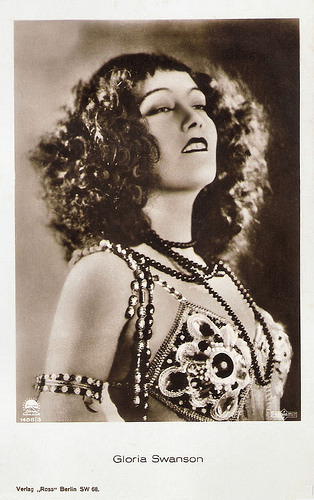
German postcard by Ross Verlag, no. 1488/3, 1927-1928. Photo: Paramount / Parafumet. Publicity still for Stage Struck (Allan Dwan, 1925).

Italian postcard, no. 139. Photo: Films Paramount Roma. Publicity still for Madame Sans-Gêne (Léonce Perret, 1925) with Emile Drain. Collection: Didier Hanson.
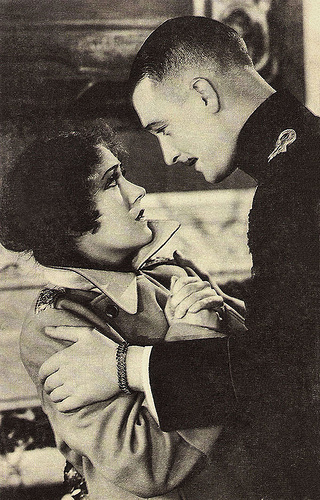
Spanish postcard by Casa Molina, Madrid. Gloria Swanson and Walter Byron in Queen Kelly (Erich von Stroheim, 1929).
The Lion's Bride
Gloria May Josephine Swanson was born in Chicago in 1899 to Adelaide (née Klanowski) and Joseph Theodore Swanson, a soldier. (Some sources list 1897 as the year of her birth.) Because of her father's attachment to the U.S. Army, the family moved frequently and Swanson ended up spending most of her childhood in Puerto Rico, where she learned Spanish. She also spent time in Key West, Florida.
It was not her intention to enter show business, but on a whim one of her aunts took her to a small film company in Chicago called Essanay Studios for a visit and Swanson was asked to come back to work as an extra. According to Wikipedia , she made her film debut there in the short The Song of Soul (1914) and according to Ed Stephan at IMDb in The Fable of Elvira and Farina and the Meal Ticket (Richard Foster Baker, 1915).
After a few months working as an extra, Swanson left school to work full-time at Essanay. She auditioned for the leading female role opposite Charlie Chaplin in His New Job (Charles Chaplin, 1915), but he instead cast her in the brief role of a stenographer. Her parents separated and she and her mother moved to California in 1916. There she appeared in Mack Sennett's Keystone comedies opposite Bobby Vernon.
In 1919 she signed a seven-year contract with Famous Players-Lasky. There director Cecil B. DeMille turned her into a romantic lead in such films as Don't Change Your Husband (1919), Male and Female (1919) with the famous scene posing as ‘the Lion's Bride’ with a real lion, Why Change Your Wife? (1920), Something to Think About (1920), and The Affairs of Anatol (1921).
In only two years, Swanson rocketed to stardom and became one of the most sought-after actresses in Hollywood. She next appeared in a series of films directed by Sam Wood, including Beyond the Rocks (1922) with Rudolph Valentino. Long believed to be a lost film, Beyond the Rocks was rediscovered in 2004 in The Netherlands. In a series of costume dramas, Swanson became the screen's first clotheshorse, ornamented with beads, jewels, peacock and ostrich feathers, and other extravagant pieces haute couture of the day.

German postcard by Ross Verlag, Berlin, no. 1091/1, 1927-1928. Photo: Paramount-Film. Publicity still for Beyond the Rocks (Sam Wood, 1922) with Rudolph Valentino.
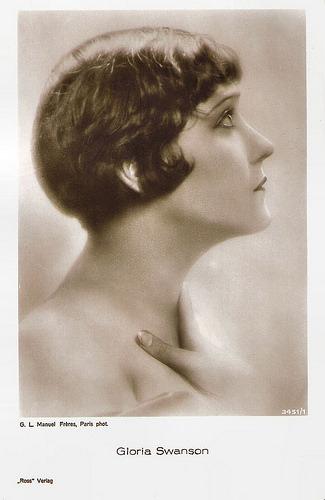
German postcard by Ross Verlag, no. 3451/1, 1928-1929. Photo: G.L. Manuel Frères, Paris.

German postcard by Ross Verlag, no. 3451/2, 1928-1929. Photo: G.L. Manuel Frères, Paris.
One of the most legendary unfinished films
Gloria Swanson favourite film was Madame Sans-Gêne (Léonce Perret, 1925), the first French-American coproduction in which both countries had a hand in the film’s development. Filming was allowed for the first time at many of the historic sites relating to Napoleon. According to Julie Buck at the Women Film Pioneers Project , “Swanson was deeply involved in every aspect of the production, including having a say in who directed and who was cast.”
Madame Sans-Gêne was well received at the time, but it is now unfortunately considered to be a lost film. During the production, Swanson met her third husband Henri, Marquis de la Falaise, who had been hired to be her translator during the film's production. After a four months residency in France she returned to the United States as European nobility, now known as the Marquise. She got a huge welcome home with parades in both New York and Los Angeles.
Swanson made a number of films for Paramount, among them Stage Struck (Allan Dwan, 1925) and Fine Manners (Richard Rosson, Lewis Milestone, 1926). In 1927, she turned down a million dollar a year contract with Paramount to join the newly created United Artists, where she was her own boss and could make the films she wanted.
Her first independent film, The Love of Sunya, (Albert Parker, 1927) is the story of a young woman granted the ability to see into her future. The production was a disaster and on the advice of Joseph Schenck, Swanson returned to Hollywood.
There she filmed the controversial Sadie Thompson (Raoul Walsh, 1928), based on a story by W. Somerset Maugham. On Broadway it had been a huge hit, but the Hays Office had explicitely banned it. Swanson tricked Hays into giving her permission to shoot and Sadie Thompson became a smash hit. The film made the top ten best pictures of the year list as well and Swanson was nominated for the Best Actress Oscar.
Her next production would become one of the most legendary unfinished films. Queen Kelly (1929) was directed by Erich von Stroheim and produced by Joseph P. Kennedy, Sr., father of the future President John F. Kennedy. Swanson starred in the title role opposite Walter Byron. Production of the costly film was shut down after complaints by Swanson about von Stroheim and the general direction the film was taking. In later interviews, she claimed that she had been misled by the script, which referred to her character arriving in, and taking over, a dance hall. Looking at the rushes, it was obvious the 'dance hall' was actually a brothel.
Von Stroheim was fired from the film. Swanson and Kennedy shot an alternative ending, photographed by Gregg Toland. The film was not theatrically released in the United States due to a clause in Stroheim's contract, but it was shown in Europe and South America with the Swanson ending tacked on. A short extract of the film appears in Sunset Boulevard (Billy Wilder, 1950), representing an old silent picture Swanson's character Norma Desmond had made. Ironically, Von Stroheim is also a primary character in Sunset Boulevard as her ex-director, ex-husband, and current butler.

Italian postcard by Ed. Ballerini & Fratini, no. 764. Photo: publicity still for Zazà (Allan Dwan, 1923).

German postcard by Ross Verlag, no. 1997/1, 1927-1928. Photo: Parufamet. Publicity still for Fine Manners (Richard Rosson, Lewis Milestone, 1926).
A glorious come-back
To try to recover from the Queen Kelly fiasco, Gloria Swanson jumped into making talkies. Her sound debut, The Trespasser (Edmund Goulding, 1929), earned Swanson her second Academy Award nomination, and was a smash hit. Follow-ups like What a Widow! (Allan Dwan, 1930), Indiscreet (Leo McCarey, 1931), and Music in the Air (Joe May, 1934) proved to be box-office flops.
Swanson relocated permanently to New York City in 1938, where she began an inventions and patents company called Multiprises, which kept her occupied during the years of World War II. This small company had the sole purpose of rescuing Jewish scientists and inventors from war-torn Europe and bringing them to the United States. She helped many escape, and some useful inventions came from the enterprise.
Swanson made another film for RKO, Father Takes a Wife (Jack Hively, 1941), began appearing in the legitimate theatre, and starred in her own television show in 1948. She threw herself into painting and sculpting, writing a syndicated column, touring in summer stock, engaging in political activism, radio and television work, clothing and accessories design and marketing, and making occasional appearances on the big screen.
In 1950 she made a glorious come-back with Sunset Boulevard (Billy Wilder, 1950), for which she earned her third Academy Award nomination. After Mae West, Mary Pickford and Pola Negri had declined the role, Swanson portrayed Norma Desmond, a faded silent movie star who falls in love with the younger screenwriter Joe Gillis, played by William Holden. Desmond lives in the past, assisted by her butler Max, played by Erich von Stroheim . Cecil B. DeMille plays himself in a pivotal scene. Some of the lines from the film have become pop-culture mainstays, including "I am big; it's the pictures that got small"; "We didn't need dialogue, we had faces"; and "All right, Mr. DeMille, I'm ready for my close-up."
Swanson received several subsequent acting offers but turned most of them down, saying they tended to be pale imitations of Norma Desmond. Her last major Hollywood role was the poorly received Three for Bedroom "C" (Milton H. Bren, 1952). In Italy, Swanson made the historical comedy Mio figlio Nerone/Nero's Mistress (Steno, 1956), which also starred Alberto Sordi , Vittorio de Sica and Brigitte Bardot . Her final screen appearance was as herself in Airport 1975 (Jack Smight, 1974).
Although Swanson only made three films after Sunset Boulevard, she starred in numerous stage and television productions during her remaining years. She was active in various business ventures, traveled extensively, wrote articles, columns, and an autobiography, painted and sculpted, and became a passionate advocate of various health and nutrition topics. In 1980, Swanson's autobiography, Swanson on Swanson, was published and became a national bestseller. Kevin Brownlow and David Gill interviewed her for the classic TV series Hollywood (1980), a history of the silent era.

French postcard by Ed. Cinémagazine, no. 162. Gloria Swanson in The Humming Bird (Sidney Olcott, 1924), released in France as Les loups de Montmartre.

German postcard by Ross Verlag, no. 1588/2, 1927-1928. Photo: United Artists.

French postcard, no. 76. Photo: Melbourne Spurr.
Forever Miss Swanson
Throughout her life and her many marriages, Gloria Swanson was always known as Miss Swanson. Though she legally took the names of her husbands, her own personality and fame always overshadowed them. Her first husband was the actor Wallace Beery, whom she married on her 17th birthday. In her autobiography Swanson on Swanson, Swanson wrote that Beery raped her on their wedding night. He also impregnated her in 1917. Not wanting her to have the child, he reportedly tricked her into drinking a concoction that induced an abortion and although they still worked together at Keystone, they separated and finally divorced two years later.
In 1919. she married Herbert K. Somborn, then president of Equity Pictures Corporation and later the owner of the Brown Derby restaurant. They had a daughter, Gloria Swanson Somborn (1920-2000) and Swanson adopted a baby boy, Sonny Smith (1922–1975), whom she renamed Joseph Patrick Swanson. Her divorce from Somborn in 1925 was sensational when he accused her of adultery with thirteen men including Cecil B. DeMille, Rudolph Valentino, and director Marshall Neilan.
Swanson's third husband was the French aristocrat Henri, Marquis de la Falaise de la Coudraye, whom she married after the Somborn divorce was finalized. Swanson was the first film star to marry European nobility, and the marriage became a global sensation. She conceived a child with him, but had an abortion, which, in her autobiography, she said she regretted. Later, Henri became a film executive representing Pathé (USA) in France through Joseph P. Kennedy, Sr., who was running the studio. This marriage ended in divorce in 1930. Soon after, Henri remarried, to actress Constance Bennett.
While still married to Henri, Swanson had an affair with the married Joseph P. Kennedy for a number of years. He became her business partner and their relationship was an open secret in Hollywood. He took over all of her personal and business affairs and was supposed to make her millions. Unfortunately, Kennedy left her after the disastrous Queen Kelly and her finances were in worse shape than when he came into her life.
In 1931, Swanson married Michael Farmer with whom she had a daughter, Michelle Bridget Farmer (1932). Swanson and Farmer divorced in 1934, after she became involved with married British actor Herbert Marshall . The media reported widely on the and after almost three years, Swanson left him once she realized he would never divorce his wife, Edna Best, for her. In 1945, Swanson married William N. Davey but divorced him in 1946.
For the next thirty years Swanson would remain unmarried and able to pursue her own interests. Swanson's final marriage, to writer William Dufty, occurred in 1976 and lasted until her death. In 1983, Gloria Swanson died in New York City in New York Hospital from a heart ailment, aged 84. Miss Swanson was survived by both of her daughters (her son had died in 1975), several grandchildren, and great-grandchildren in the United States and France.

Italian postcard, no. 58. Photo: Artisti Associati (United Artists). Publcity still for The Love of Sunya (Albert Parker, 1927).

Austrian postcard by Iris Verlag, no. 904. Photo: United Artists / Verleih Projectograph-Film.
Trailer for Madame Sans-Gêne (1925). Source: historycomestolife (YouTube).
Trailer Sunset Boulevard (1950). Source: Ageless Trailers (YouTube).
Sources: Julie Buck (Women Film Pioneers Project), (IMDb), Wikipedia and .

German postcard by Ross Verlag, no. 1488/3, 1927-1928. Photo: Paramount / Parafumet. Publicity still for Stage Struck (Allan Dwan, 1925).

Italian postcard, no. 139. Photo: Films Paramount Roma. Publicity still for Madame Sans-Gêne (Léonce Perret, 1925) with Emile Drain. Collection: Didier Hanson.

Spanish postcard by Casa Molina, Madrid. Gloria Swanson and Walter Byron in Queen Kelly (Erich von Stroheim, 1929).
The Lion's Bride
Gloria May Josephine Swanson was born in Chicago in 1899 to Adelaide (née Klanowski) and Joseph Theodore Swanson, a soldier. (Some sources list 1897 as the year of her birth.) Because of her father's attachment to the U.S. Army, the family moved frequently and Swanson ended up spending most of her childhood in Puerto Rico, where she learned Spanish. She also spent time in Key West, Florida.
It was not her intention to enter show business, but on a whim one of her aunts took her to a small film company in Chicago called Essanay Studios for a visit and Swanson was asked to come back to work as an extra. According to Wikipedia , she made her film debut there in the short The Song of Soul (1914) and according to Ed Stephan at IMDb in The Fable of Elvira and Farina and the Meal Ticket (Richard Foster Baker, 1915).
After a few months working as an extra, Swanson left school to work full-time at Essanay. She auditioned for the leading female role opposite Charlie Chaplin in His New Job (Charles Chaplin, 1915), but he instead cast her in the brief role of a stenographer. Her parents separated and she and her mother moved to California in 1916. There she appeared in Mack Sennett's Keystone comedies opposite Bobby Vernon.
In 1919 she signed a seven-year contract with Famous Players-Lasky. There director Cecil B. DeMille turned her into a romantic lead in such films as Don't Change Your Husband (1919), Male and Female (1919) with the famous scene posing as ‘the Lion's Bride’ with a real lion, Why Change Your Wife? (1920), Something to Think About (1920), and The Affairs of Anatol (1921).
In only two years, Swanson rocketed to stardom and became one of the most sought-after actresses in Hollywood. She next appeared in a series of films directed by Sam Wood, including Beyond the Rocks (1922) with Rudolph Valentino. Long believed to be a lost film, Beyond the Rocks was rediscovered in 2004 in The Netherlands. In a series of costume dramas, Swanson became the screen's first clotheshorse, ornamented with beads, jewels, peacock and ostrich feathers, and other extravagant pieces haute couture of the day.

German postcard by Ross Verlag, Berlin, no. 1091/1, 1927-1928. Photo: Paramount-Film. Publicity still for Beyond the Rocks (Sam Wood, 1922) with Rudolph Valentino.

German postcard by Ross Verlag, no. 3451/1, 1928-1929. Photo: G.L. Manuel Frères, Paris.

German postcard by Ross Verlag, no. 3451/2, 1928-1929. Photo: G.L. Manuel Frères, Paris.
One of the most legendary unfinished films
Gloria Swanson favourite film was Madame Sans-Gêne (Léonce Perret, 1925), the first French-American coproduction in which both countries had a hand in the film’s development. Filming was allowed for the first time at many of the historic sites relating to Napoleon. According to Julie Buck at the Women Film Pioneers Project , “Swanson was deeply involved in every aspect of the production, including having a say in who directed and who was cast.”
Madame Sans-Gêne was well received at the time, but it is now unfortunately considered to be a lost film. During the production, Swanson met her third husband Henri, Marquis de la Falaise, who had been hired to be her translator during the film's production. After a four months residency in France she returned to the United States as European nobility, now known as the Marquise. She got a huge welcome home with parades in both New York and Los Angeles.
Swanson made a number of films for Paramount, among them Stage Struck (Allan Dwan, 1925) and Fine Manners (Richard Rosson, Lewis Milestone, 1926). In 1927, she turned down a million dollar a year contract with Paramount to join the newly created United Artists, where she was her own boss and could make the films she wanted.
Her first independent film, The Love of Sunya, (Albert Parker, 1927) is the story of a young woman granted the ability to see into her future. The production was a disaster and on the advice of Joseph Schenck, Swanson returned to Hollywood.
There she filmed the controversial Sadie Thompson (Raoul Walsh, 1928), based on a story by W. Somerset Maugham. On Broadway it had been a huge hit, but the Hays Office had explicitely banned it. Swanson tricked Hays into giving her permission to shoot and Sadie Thompson became a smash hit. The film made the top ten best pictures of the year list as well and Swanson was nominated for the Best Actress Oscar.
Her next production would become one of the most legendary unfinished films. Queen Kelly (1929) was directed by Erich von Stroheim and produced by Joseph P. Kennedy, Sr., father of the future President John F. Kennedy. Swanson starred in the title role opposite Walter Byron. Production of the costly film was shut down after complaints by Swanson about von Stroheim and the general direction the film was taking. In later interviews, she claimed that she had been misled by the script, which referred to her character arriving in, and taking over, a dance hall. Looking at the rushes, it was obvious the 'dance hall' was actually a brothel.
Von Stroheim was fired from the film. Swanson and Kennedy shot an alternative ending, photographed by Gregg Toland. The film was not theatrically released in the United States due to a clause in Stroheim's contract, but it was shown in Europe and South America with the Swanson ending tacked on. A short extract of the film appears in Sunset Boulevard (Billy Wilder, 1950), representing an old silent picture Swanson's character Norma Desmond had made. Ironically, Von Stroheim is also a primary character in Sunset Boulevard as her ex-director, ex-husband, and current butler.

Italian postcard by Ed. Ballerini & Fratini, no. 764. Photo: publicity still for Zazà (Allan Dwan, 1923).

German postcard by Ross Verlag, no. 1997/1, 1927-1928. Photo: Parufamet. Publicity still for Fine Manners (Richard Rosson, Lewis Milestone, 1926).
A glorious come-back
To try to recover from the Queen Kelly fiasco, Gloria Swanson jumped into making talkies. Her sound debut, The Trespasser (Edmund Goulding, 1929), earned Swanson her second Academy Award nomination, and was a smash hit. Follow-ups like What a Widow! (Allan Dwan, 1930), Indiscreet (Leo McCarey, 1931), and Music in the Air (Joe May, 1934) proved to be box-office flops.
Swanson relocated permanently to New York City in 1938, where she began an inventions and patents company called Multiprises, which kept her occupied during the years of World War II. This small company had the sole purpose of rescuing Jewish scientists and inventors from war-torn Europe and bringing them to the United States. She helped many escape, and some useful inventions came from the enterprise.
Swanson made another film for RKO, Father Takes a Wife (Jack Hively, 1941), began appearing in the legitimate theatre, and starred in her own television show in 1948. She threw herself into painting and sculpting, writing a syndicated column, touring in summer stock, engaging in political activism, radio and television work, clothing and accessories design and marketing, and making occasional appearances on the big screen.
In 1950 she made a glorious come-back with Sunset Boulevard (Billy Wilder, 1950), for which she earned her third Academy Award nomination. After Mae West, Mary Pickford and Pola Negri had declined the role, Swanson portrayed Norma Desmond, a faded silent movie star who falls in love with the younger screenwriter Joe Gillis, played by William Holden. Desmond lives in the past, assisted by her butler Max, played by Erich von Stroheim . Cecil B. DeMille plays himself in a pivotal scene. Some of the lines from the film have become pop-culture mainstays, including "I am big; it's the pictures that got small"; "We didn't need dialogue, we had faces"; and "All right, Mr. DeMille, I'm ready for my close-up."
Swanson received several subsequent acting offers but turned most of them down, saying they tended to be pale imitations of Norma Desmond. Her last major Hollywood role was the poorly received Three for Bedroom "C" (Milton H. Bren, 1952). In Italy, Swanson made the historical comedy Mio figlio Nerone/Nero's Mistress (Steno, 1956), which also starred Alberto Sordi , Vittorio de Sica and Brigitte Bardot . Her final screen appearance was as herself in Airport 1975 (Jack Smight, 1974).
Although Swanson only made three films after Sunset Boulevard, she starred in numerous stage and television productions during her remaining years. She was active in various business ventures, traveled extensively, wrote articles, columns, and an autobiography, painted and sculpted, and became a passionate advocate of various health and nutrition topics. In 1980, Swanson's autobiography, Swanson on Swanson, was published and became a national bestseller. Kevin Brownlow and David Gill interviewed her for the classic TV series Hollywood (1980), a history of the silent era.

French postcard by Ed. Cinémagazine, no. 162. Gloria Swanson in The Humming Bird (Sidney Olcott, 1924), released in France as Les loups de Montmartre.

German postcard by Ross Verlag, no. 1588/2, 1927-1928. Photo: United Artists.

French postcard, no. 76. Photo: Melbourne Spurr.
Forever Miss Swanson
Throughout her life and her many marriages, Gloria Swanson was always known as Miss Swanson. Though she legally took the names of her husbands, her own personality and fame always overshadowed them. Her first husband was the actor Wallace Beery, whom she married on her 17th birthday. In her autobiography Swanson on Swanson, Swanson wrote that Beery raped her on their wedding night. He also impregnated her in 1917. Not wanting her to have the child, he reportedly tricked her into drinking a concoction that induced an abortion and although they still worked together at Keystone, they separated and finally divorced two years later.
In 1919. she married Herbert K. Somborn, then president of Equity Pictures Corporation and later the owner of the Brown Derby restaurant. They had a daughter, Gloria Swanson Somborn (1920-2000) and Swanson adopted a baby boy, Sonny Smith (1922–1975), whom she renamed Joseph Patrick Swanson. Her divorce from Somborn in 1925 was sensational when he accused her of adultery with thirteen men including Cecil B. DeMille, Rudolph Valentino, and director Marshall Neilan.
Swanson's third husband was the French aristocrat Henri, Marquis de la Falaise de la Coudraye, whom she married after the Somborn divorce was finalized. Swanson was the first film star to marry European nobility, and the marriage became a global sensation. She conceived a child with him, but had an abortion, which, in her autobiography, she said she regretted. Later, Henri became a film executive representing Pathé (USA) in France through Joseph P. Kennedy, Sr., who was running the studio. This marriage ended in divorce in 1930. Soon after, Henri remarried, to actress Constance Bennett.
While still married to Henri, Swanson had an affair with the married Joseph P. Kennedy for a number of years. He became her business partner and their relationship was an open secret in Hollywood. He took over all of her personal and business affairs and was supposed to make her millions. Unfortunately, Kennedy left her after the disastrous Queen Kelly and her finances were in worse shape than when he came into her life.
In 1931, Swanson married Michael Farmer with whom she had a daughter, Michelle Bridget Farmer (1932). Swanson and Farmer divorced in 1934, after she became involved with married British actor Herbert Marshall . The media reported widely on the and after almost three years, Swanson left him once she realized he would never divorce his wife, Edna Best, for her. In 1945, Swanson married William N. Davey but divorced him in 1946.
For the next thirty years Swanson would remain unmarried and able to pursue her own interests. Swanson's final marriage, to writer William Dufty, occurred in 1976 and lasted until her death. In 1983, Gloria Swanson died in New York City in New York Hospital from a heart ailment, aged 84. Miss Swanson was survived by both of her daughters (her son had died in 1975), several grandchildren, and great-grandchildren in the United States and France.

Italian postcard, no. 58. Photo: Artisti Associati (United Artists). Publcity still for The Love of Sunya (Albert Parker, 1927).

Austrian postcard by Iris Verlag, no. 904. Photo: United Artists / Verleih Projectograph-Film.
Trailer for Madame Sans-Gêne (1925). Source: historycomestolife (YouTube).
Trailer Sunset Boulevard (1950). Source: Ageless Trailers (YouTube).
Sources: Julie Buck (Women Film Pioneers Project), (IMDb), Wikipedia and .
Published on November 20, 2015 22:00
November 19, 2015
EFSP's Dazzling Dozen: the Eurospy Craze
During the 1960s, the hugely successful James Bond film series initiated a new European film genre, the Eurospy film. In 1964, two years after the release of the first James Bond film, Dr. No (1962), and the same year of the release of Goldfinger (1964), a large wave of espionage films was released. These European international co-productions imitated and/or parodied the 007 films.

British postcard by Klasik Kards, London, no. 1543. Photos: publicity stills for From Russia with Love (Terence Young, 1963) with Sean Connery as James Bond, Daniela Bianchi and Martine Beswick. Scottish superstar Sean Connery (1930) played the original secret agent 007 in seven James Bond films between 1962 and 1983 - all were big box-office hits.
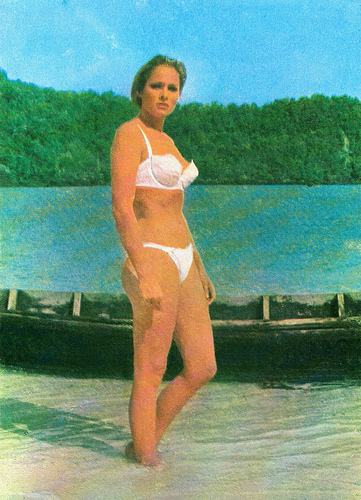
Serbian postcard by Cik Razolednica. Photo: publicity still for Dr. No (1962). Stunning Swiss sex symbol, starlet and jet-setter Ursula Andress (1936) will always be remembered as the first and quintessential Bond girl. In Dr. No (1962) she made film history when she spectacularly rises out of the Caribbean Sea in a white bikini.

Dutch postcard. Sent by mail in 1966. Publicity still for Goldfinger (1964) with Sean Connery as James Bond and Gert Fröbe as Auric Goldfinger.
A Spy Wave
Dr. No (Terence Young, 1962) and especially Goldfinger (Guy Hamilton, 1964) - the third and quintessential episode of the James Bond series - created a large wave of Eurospy films.
Michael Caine became the cool special agent Harry Palmer, and Richard Johnson played agent Bulldog Drummond.
There were popular Eurospy films from France (a series around Hubert Bonisseur de La Bath, aka OSS 117) and Germany (the Kommissar X and the Jerry Cotton series), but most of the Eurospy films were produced in Italy.
There, the Eurospy trend replaced the Peplum films, the declining sword and sandal genre. The heroes of these films were secret agents who were often given a name similar to James Bond (Charles Bind, Charles Vine or James Tont), or a code name matching, or similar to, James Bond's '007'.
Many films featured former Hollywood B-stars like George Nader , Gordon Scott , Lex Barker and Jacques Bergerac .
And British TV followed the trend with such delightful sixties series as The Saint, Danger Man and especially The Avengers.

German postcard by Franz Josef Rüdel, Filmpostkartenverlag, Hamburg, no. 4250. Photo: Constantin / Studio Hamburg / Allianz / Astoria / Winterstein. Publicity still for Schüsse aus dem Geigenkasten/Operation Hurricane: Friday Noon (Fritz Umgelter, 1965) with George Nader as Jerry Cotton. Ruggedly handsome American actor George Nader (1921-2002) was a Universal star of second features in the 1950s. During the 1960s, Nader’s career had a second life in the European cinema as secret agent Jerry Cotton.

German postcard by Franz Josef Rüdel, Filmpostkartenverlag, Hamburg. Photo: Constantin. Publicity still for Der Tod im Roten Jaguar/Death in the Red Jaguar (Harald Reinl, 1968) with George Nader as Jerry Cotton.
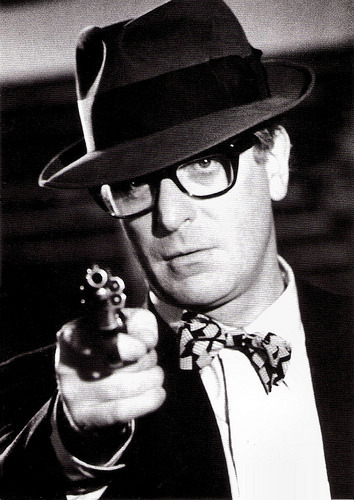
British postcard by Boomerang. Photo: Everett Collection. Michael Caine (1930) became an unusual but ultra cool star of the British cinema of the 1960s with his role of the spy Harry Palmer in The Ipcress File (Sidney J. Furie, 1965) and its four sequels.
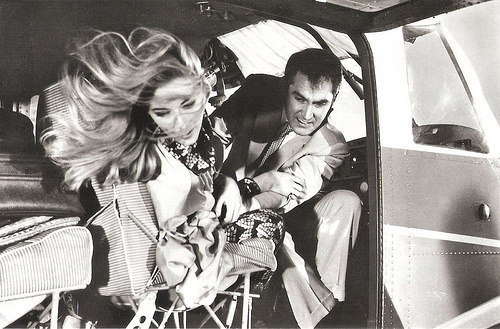
Romanian postcard by Casa Filmului Acin. Photo: Publicity still for the Italian-French-Spanish Eurospy film Missione speciale Lady Chaplin/Operation Lady Chaplin (Alberto De Martino, Sergio Grieco, 1966) with Daniela Bianchi and Jacques Bergerac . The film was a part of the Secret Agent 077 trilogy and starred Ken Clark. Italian actress Daniela Bianchi (1942) also played luscious Soviet cipher clerk Tatiana Romanova in From Russia with Love (1963). One of her otherEurospy films was Operation Kid Brother/OK Connery (Alberto de Martino, 1967), a James Bond spoof starring Sean Connery 's younger brother, Neil Connery.

French postcard by Universal Collections, 2002. Photo: Canal+ Image UK Ltd. The Avengers (1961-1969) is a delicious, quirky Spy-Fi television series set in cold war Britain. In one hour episodes, The Avengers focused on the adventures of eccentric, suave British agent John Steed (Patrick Macnee) working for the 'Ministry'. His most popular investigative partner was Diana Rigg's Emma Peel, who combined self-assuredness with superior fighting skills, intelligence, and a contemporary fashion sense.
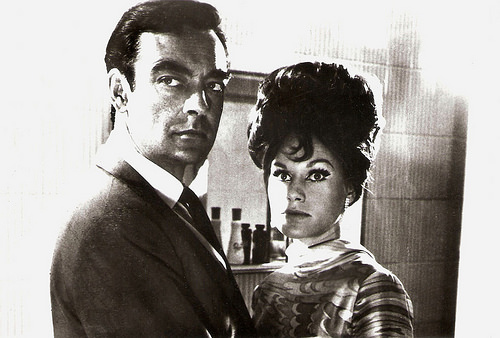
Romanian postcard by Casa Filmului Acin. Photo: publicity still for Deadlier than the male (Ralph Thomas, 1967) with Richard Johnson as Bulldog Drummond and Suzanna Leigh. Johnson was considered for the role of James Bond in the first Bond film, Dr. No (1962). He declined the part as he did not favour a lengthy contract. He then played a modern-day Bulldog Drummond (reimagined as a 007-type hero) in Deadlier Than the Male (Ralph Thomas, 1967) and its less satisfactory sequel, Some Girls Do (Ralph Thomas, 1969) .

Dutch postcard by Loeb Uitgevers BV, Amsterdam, no. 5992109, 1985. Photo: Eon Productions / Gilrose Publications / Danjaq S.A. Publicity still for The Man with the Golden Gun (Guy Hamilton, 1974) with Christopher Lee and Roger Moore as James Bond. In 1973 Moore replaced Sean Connery as 007 and till 1983 Moore starred in seven Bond films.
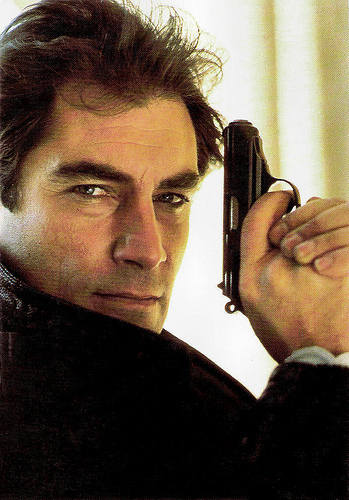
British postcard by Danjaq A.S. / United Artists, 1987. Photo: publicity still for The Living Daylights (John Glen, 1987). Timothy Dalton (1944) played James Bond in The Living Daylights (John Glen, 1987) and Licence to Kill (John Glen, 1989). His first outing as Bond, The Living Daylights (1987), was critically successful, and grossed more than the previous two Bond films with Roger Moore .

British postcard by Santoro Graphics, London, no. BW 136. Photo: Paul Cox / Idols. British actor Jason Connery (1963) is the son of Sean Connery . Jason portrayed author Ian Fleming in the television drama Spymaker: The Secret Life of Ian Fleming (Ferdinand Fairfax, 1990). Fleming was the creator of the James Bond character, which had made father Sean into an icon and had started the Eurospy craze.
This is a post for Postcard Friendship Friday, hosted by Beth at the The Best Hearts are Crunchy. You can visit her by clicking on the button below.

Sources: Wikipedia and IMDb.

British postcard by Klasik Kards, London, no. 1543. Photos: publicity stills for From Russia with Love (Terence Young, 1963) with Sean Connery as James Bond, Daniela Bianchi and Martine Beswick. Scottish superstar Sean Connery (1930) played the original secret agent 007 in seven James Bond films between 1962 and 1983 - all were big box-office hits.

Serbian postcard by Cik Razolednica. Photo: publicity still for Dr. No (1962). Stunning Swiss sex symbol, starlet and jet-setter Ursula Andress (1936) will always be remembered as the first and quintessential Bond girl. In Dr. No (1962) she made film history when she spectacularly rises out of the Caribbean Sea in a white bikini.

Dutch postcard. Sent by mail in 1966. Publicity still for Goldfinger (1964) with Sean Connery as James Bond and Gert Fröbe as Auric Goldfinger.
A Spy Wave
Dr. No (Terence Young, 1962) and especially Goldfinger (Guy Hamilton, 1964) - the third and quintessential episode of the James Bond series - created a large wave of Eurospy films.
Michael Caine became the cool special agent Harry Palmer, and Richard Johnson played agent Bulldog Drummond.
There were popular Eurospy films from France (a series around Hubert Bonisseur de La Bath, aka OSS 117) and Germany (the Kommissar X and the Jerry Cotton series), but most of the Eurospy films were produced in Italy.
There, the Eurospy trend replaced the Peplum films, the declining sword and sandal genre. The heroes of these films were secret agents who were often given a name similar to James Bond (Charles Bind, Charles Vine or James Tont), or a code name matching, or similar to, James Bond's '007'.
Many films featured former Hollywood B-stars like George Nader , Gordon Scott , Lex Barker and Jacques Bergerac .
And British TV followed the trend with such delightful sixties series as The Saint, Danger Man and especially The Avengers.

German postcard by Franz Josef Rüdel, Filmpostkartenverlag, Hamburg, no. 4250. Photo: Constantin / Studio Hamburg / Allianz / Astoria / Winterstein. Publicity still for Schüsse aus dem Geigenkasten/Operation Hurricane: Friday Noon (Fritz Umgelter, 1965) with George Nader as Jerry Cotton. Ruggedly handsome American actor George Nader (1921-2002) was a Universal star of second features in the 1950s. During the 1960s, Nader’s career had a second life in the European cinema as secret agent Jerry Cotton.

German postcard by Franz Josef Rüdel, Filmpostkartenverlag, Hamburg. Photo: Constantin. Publicity still for Der Tod im Roten Jaguar/Death in the Red Jaguar (Harald Reinl, 1968) with George Nader as Jerry Cotton.

British postcard by Boomerang. Photo: Everett Collection. Michael Caine (1930) became an unusual but ultra cool star of the British cinema of the 1960s with his role of the spy Harry Palmer in The Ipcress File (Sidney J. Furie, 1965) and its four sequels.

Romanian postcard by Casa Filmului Acin. Photo: Publicity still for the Italian-French-Spanish Eurospy film Missione speciale Lady Chaplin/Operation Lady Chaplin (Alberto De Martino, Sergio Grieco, 1966) with Daniela Bianchi and Jacques Bergerac . The film was a part of the Secret Agent 077 trilogy and starred Ken Clark. Italian actress Daniela Bianchi (1942) also played luscious Soviet cipher clerk Tatiana Romanova in From Russia with Love (1963). One of her otherEurospy films was Operation Kid Brother/OK Connery (Alberto de Martino, 1967), a James Bond spoof starring Sean Connery 's younger brother, Neil Connery.

French postcard by Universal Collections, 2002. Photo: Canal+ Image UK Ltd. The Avengers (1961-1969) is a delicious, quirky Spy-Fi television series set in cold war Britain. In one hour episodes, The Avengers focused on the adventures of eccentric, suave British agent John Steed (Patrick Macnee) working for the 'Ministry'. His most popular investigative partner was Diana Rigg's Emma Peel, who combined self-assuredness with superior fighting skills, intelligence, and a contemporary fashion sense.

Romanian postcard by Casa Filmului Acin. Photo: publicity still for Deadlier than the male (Ralph Thomas, 1967) with Richard Johnson as Bulldog Drummond and Suzanna Leigh. Johnson was considered for the role of James Bond in the first Bond film, Dr. No (1962). He declined the part as he did not favour a lengthy contract. He then played a modern-day Bulldog Drummond (reimagined as a 007-type hero) in Deadlier Than the Male (Ralph Thomas, 1967) and its less satisfactory sequel, Some Girls Do (Ralph Thomas, 1969) .

Dutch postcard by Loeb Uitgevers BV, Amsterdam, no. 5992109, 1985. Photo: Eon Productions / Gilrose Publications / Danjaq S.A. Publicity still for The Man with the Golden Gun (Guy Hamilton, 1974) with Christopher Lee and Roger Moore as James Bond. In 1973 Moore replaced Sean Connery as 007 and till 1983 Moore starred in seven Bond films.

British postcard by Danjaq A.S. / United Artists, 1987. Photo: publicity still for The Living Daylights (John Glen, 1987). Timothy Dalton (1944) played James Bond in The Living Daylights (John Glen, 1987) and Licence to Kill (John Glen, 1989). His first outing as Bond, The Living Daylights (1987), was critically successful, and grossed more than the previous two Bond films with Roger Moore .

British postcard by Santoro Graphics, London, no. BW 136. Photo: Paul Cox / Idols. British actor Jason Connery (1963) is the son of Sean Connery . Jason portrayed author Ian Fleming in the television drama Spymaker: The Secret Life of Ian Fleming (Ferdinand Fairfax, 1990). Fleming was the creator of the James Bond character, which had made father Sean into an icon and had started the Eurospy craze.
This is a post for Postcard Friendship Friday, hosted by Beth at the The Best Hearts are Crunchy. You can visit her by clicking on the button below.

Sources: Wikipedia and IMDb.
Published on November 19, 2015 22:00
November 18, 2015
Die Claudi vom Geiserhof (1917)
Henny Porten was the star of the silent mountain drama Die Claudi vom Geiserhof/Claudi of the Geiserhof (Rudolf Biebrach, 1917). This Messter Film production premiered at the Mozartsaal in Berlin, on 28 September 1917. The later director Karl Freund did the cinematography of the beautiful mountain landscapes.

German postcard by Rotophot in the Film Sterne series, no. 145. Photo: Messter Film, Berlin. Publicity still for Die Claudi vom Geiserhof/Claudi of the Geiserhof (Rudolf Biebrach, 1917).

German postcard by Rotophot in the Film Sterne series, no. 509/1. Photo: Messter Film, Berlin. Publicity still for Die Claudi vom Geiserhof/Claudi of the Geiserhof (Rudolf Biebrach, 1917).

German postcard by Rotophot in the Film Sterne series, no. 509/3. Photo: Messter Film, Berlin. Publicity still for Die Claudi vom Geiserhof/Claudi of the Geiserhof (Rudolf Biebrach, 1917).
Shame and scorn
In Die Claudi vom Geiserhof (1917), simple but honest Claudi ( Henny Porten ) suffers under her grim and taciturn father (Eduard von Winterstein), who always had wanted a son instead of a daughter. The situation worsens when Claudi gets pregnant from the son ( Paul Hartmann ) of a rich farmer, who refuses to marry her.
Unable to stand the shame and scorn, the father kicks his daughter and her young baby out of the Geiserhof farm. The old farmhand Jörgl (Lupu Pick) and the father (Josef Klein) of the scoundrel who caused Claudi's misery prevent her from throwing herself from a cliff.
Years pass. Claudi has moved in with her lover's father, while the lover has left long ago as he disobeyed his father to marry the girl. Claudi's own father has become a recluse and misanthropist. When an avalanche buries him, Claudi returns to life. The lover's father offers to marry Claudi to turn her into a respectable woman, while Claudi's son manages to reconcile Claudi and her father, who miraculously has survived the avalanche.
When noticing this all, the lover repents and throws himself into an abyss on the spot where Claudi wanted to jump, together with her child.

German postcard by Rotophot in the Film Sterne series, no. 509/4. Photo: Messter Film, Berlin. Publicity still for Die Claudi vom Geiserhof/Claudi of the Geiserhof (Rudolf Biebrach, 1917).

German postcard by Rotophot in the Film-Sterne, no. 509/5. Photo: Messter Film. Publicity still for Die Claudi vom Geiserhof/Claudi of the Geiserhof (Rudolf Biebrach, 1917).

German postcard by Rotophot in the Film Sterne series, no. 509/6. Photo: Messter Film, Berlin. Publicity still for Die Claudi vom Geiserhof/Claudi of the Geiserhof (Rudolf Biebrach, 1917).

German postcard by Rotophot in the Film Sterne series, no. 509/7. Photo: Messter Film, Berlin. Publicity still for Die Claudi vom Geiserhof/Claudi of the Geiserhof (Rudolf Biebrach, 1917).
Sources: The German Early Cinema Database, Wikipedia (German) and IMDb.

German postcard by Rotophot in the Film Sterne series, no. 145. Photo: Messter Film, Berlin. Publicity still for Die Claudi vom Geiserhof/Claudi of the Geiserhof (Rudolf Biebrach, 1917).

German postcard by Rotophot in the Film Sterne series, no. 509/1. Photo: Messter Film, Berlin. Publicity still for Die Claudi vom Geiserhof/Claudi of the Geiserhof (Rudolf Biebrach, 1917).

German postcard by Rotophot in the Film Sterne series, no. 509/3. Photo: Messter Film, Berlin. Publicity still for Die Claudi vom Geiserhof/Claudi of the Geiserhof (Rudolf Biebrach, 1917).
Shame and scorn
In Die Claudi vom Geiserhof (1917), simple but honest Claudi ( Henny Porten ) suffers under her grim and taciturn father (Eduard von Winterstein), who always had wanted a son instead of a daughter. The situation worsens when Claudi gets pregnant from the son ( Paul Hartmann ) of a rich farmer, who refuses to marry her.
Unable to stand the shame and scorn, the father kicks his daughter and her young baby out of the Geiserhof farm. The old farmhand Jörgl (Lupu Pick) and the father (Josef Klein) of the scoundrel who caused Claudi's misery prevent her from throwing herself from a cliff.
Years pass. Claudi has moved in with her lover's father, while the lover has left long ago as he disobeyed his father to marry the girl. Claudi's own father has become a recluse and misanthropist. When an avalanche buries him, Claudi returns to life. The lover's father offers to marry Claudi to turn her into a respectable woman, while Claudi's son manages to reconcile Claudi and her father, who miraculously has survived the avalanche.
When noticing this all, the lover repents and throws himself into an abyss on the spot where Claudi wanted to jump, together with her child.

German postcard by Rotophot in the Film Sterne series, no. 509/4. Photo: Messter Film, Berlin. Publicity still for Die Claudi vom Geiserhof/Claudi of the Geiserhof (Rudolf Biebrach, 1917).

German postcard by Rotophot in the Film-Sterne, no. 509/5. Photo: Messter Film. Publicity still for Die Claudi vom Geiserhof/Claudi of the Geiserhof (Rudolf Biebrach, 1917).

German postcard by Rotophot in the Film Sterne series, no. 509/6. Photo: Messter Film, Berlin. Publicity still for Die Claudi vom Geiserhof/Claudi of the Geiserhof (Rudolf Biebrach, 1917).

German postcard by Rotophot in the Film Sterne series, no. 509/7. Photo: Messter Film, Berlin. Publicity still for Die Claudi vom Geiserhof/Claudi of the Geiserhof (Rudolf Biebrach, 1917).
Sources: The German Early Cinema Database, Wikipedia (German) and IMDb.
Published on November 18, 2015 22:00
Paul van Yperen's Blog
- Paul van Yperen's profile
- 13 followers
Paul van Yperen isn't a Goodreads Author
(yet),
but they
do have a blog,
so here are some recent posts imported from
their feed.



